
Bison blog
Banff National Park
Reintroducing Plains Bison to Banff National Park
The reintroduction of Plains Bison to Banff National Park is reversing the cascade of adverse ecological and cultural impacts caused by their near-extinction from North America over 140 years ago.
- 16 healthy Plains Bison reintroduced in 2017
- Over 130 Plains Bison on the landscape in 2024
The project has created a new, growing herd and set a strong foundation of knowledge and best practices to inspire and support allyship for similar reintroductions by Indigenous Peoples and conservation practitioners elsewhere.
-
August 10, 2021: Take a walk on the wild side
August 10, 2021: Take a walk on the wild side
We never said this project was going to be easy. Re-introducing bison to Banff National Park is a complex and rewarding journey. However, this project has proved that ambitious restoration efforts are possible – but complicated.
This spring started off strong for the Banff Bison. The bison herd has welcomed in 16 new calves, bringing the size of the herd to 66 animals. In addition, four cows from the original herd have young of the year, and the number of potential breeding age cows is now between 17 and 20.
By comparison, the bison herd had three new calves in 2019 and 16 new calves in 2020.
.jpg)
During trips into the backcountry, we’ve observed the bison herd spending less time together as a cohesive unit. Instead, smaller groups stay in separate habitat patches, which is common bison behaviour, as their population increases. The herd appears healthy and in good condition.
.jpg)
Overall, the bison are doing well. They use areas across the 1,200 square kilometre re-introduction zone, and the animals are moving quickly across their preferred habitat ranges. They have spent three straight summers using high alpine areas. They could be doing so to escape bugs and heat or to feed on more nutritious forage.
.jpg)
But there is always a chance that a bison takes a walk on the wild side.
In August 2021, a young bison bull (3.5 years old) born in Banff, wandered 9 km outside the park to the east.
The young bull was likely hazed out of the main re-introduced herd by older bulls during the competitive breeding season. He may have wandered outside of the national park in search of other mating opportunities.
The bull’s behaviour was not typical; bison usually flee upon seeing humans.
.jpg)
Elevated breeding hormones could partly explain this bull’s behaviour. Sightings of the bull were reported by three horse parties in the area. The bull was said to have displayed similar behaviour that was described as “unconcerned,” “tame”, “bold”, and “playful.”
.jpg)
The bull wandered outside the park boundary to a popular backcountry campground in the Clearwater area. This area is well outside of the target reintroduction zone for the bison and, per Parks Canada’s agreement with the Province of Alberta, Parks Canada staff visited the area to assess the situation.
After evaluating the options, Parks Canada’s staff made the difficult decision to humanely destroy the young bull.
The decision to not capture and return the bison to the park considered the following:
- The animal’s age, sex, and the fact that the bison rut was ongoing, it was unlikely that such a translocation would have been successful in the long term.
- The animal’s location, and the logistics of safely and humanely capturing and moving such a large animal under the ambient weather conditions.
This was a tough day for Parks Canada staff who work hard to protect these animals. The destruction of any animal is always a last resort and only used when visitor safety or significant values are at risk.
.jpg)
The remaining 65 animals continue to thrive in the heart of the reintroduction zone of Banff National Park’s backcountry, where they have continued to give birth to calves, are feeding and bedding, and have had initial encounters with Banff’s other wildlife, including bears and wolves.
Reintroducing plains bison to Canada’s first national park is an exciting and adaptive process – but not always an easy one. We ask for understanding and patience from the public and our valued stakeholders as we work towards a long-term vision of restoring North America’s largest land mammal to Canada’s first national park.
-
March 4, 2021: Herding bison, the low-stress way
March 4, 2021: Herding bison, the low-stress way
When it comes to herding wild bison, it’s all about keeping a calm vibe.
#Banffbison sometimes drift to the edge of their 1200 km2 reintroduction zone, meaning we have to gently push them back using low-stress herding methods. We haven’t had to do it often – less than a dozen times in 2.5 years. It’s one of many tools we have to help them get used to their new home range (check out our June 2018 post on prescribed fire).
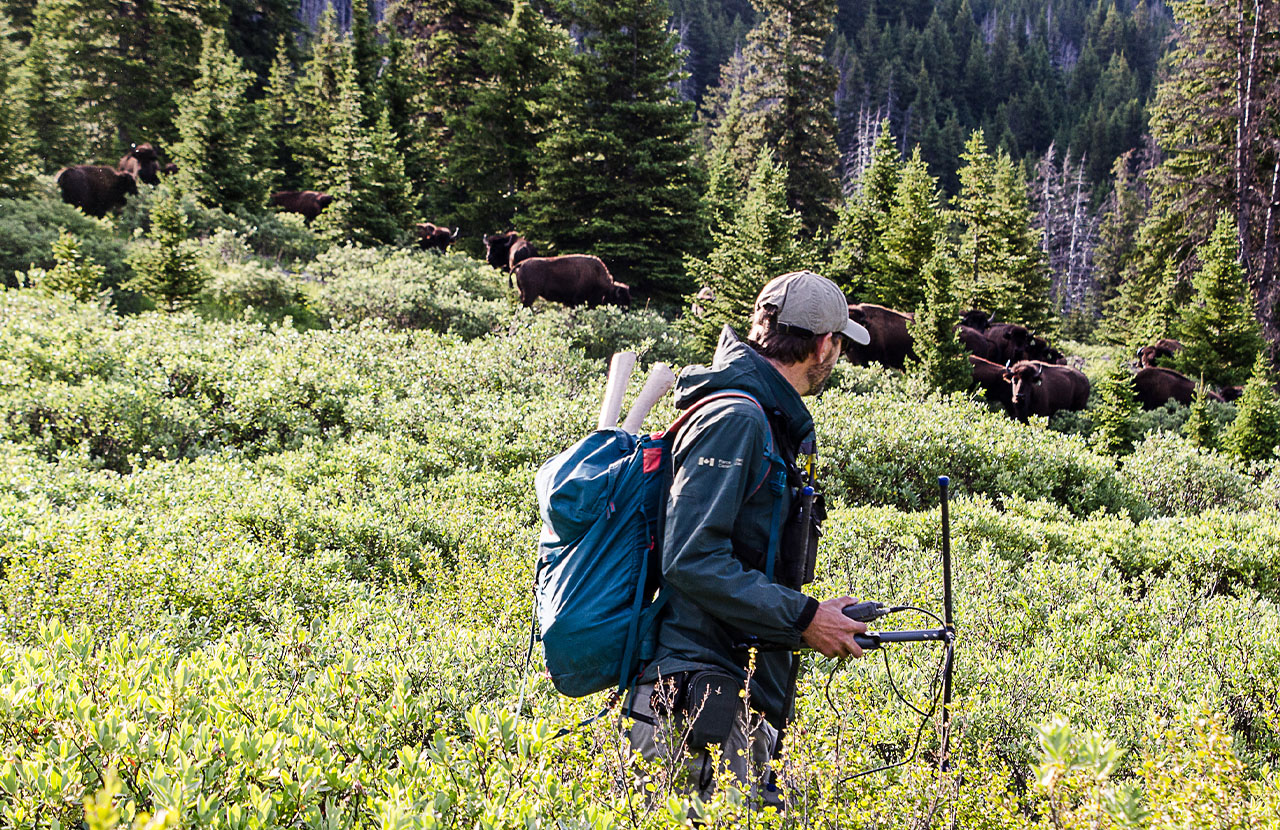
K. Heuer/Parks Canada
Low-stress herding works with the natural instincts of the bison and keeps them calm so that we can direct their movement. We use simple but steady movements in the space between their pressure zone (the distance at which bison acknowledge us) and their flight zone (the distance at which bison begin to move away) to gently shift them where we want them to go. We patiently wait for them to respond at their pace, not ours. Simply put, we try to make our idea, their idea.
It’s important that the bison don’t feel stressed or threatened, so whether we are herding them from horseback, foot, or from a helicopter, we stay a safe distance away and keep the bison moving at a calm walk. This way, the animals can think about and respond to the directions we give them, and not bolt away in fear.
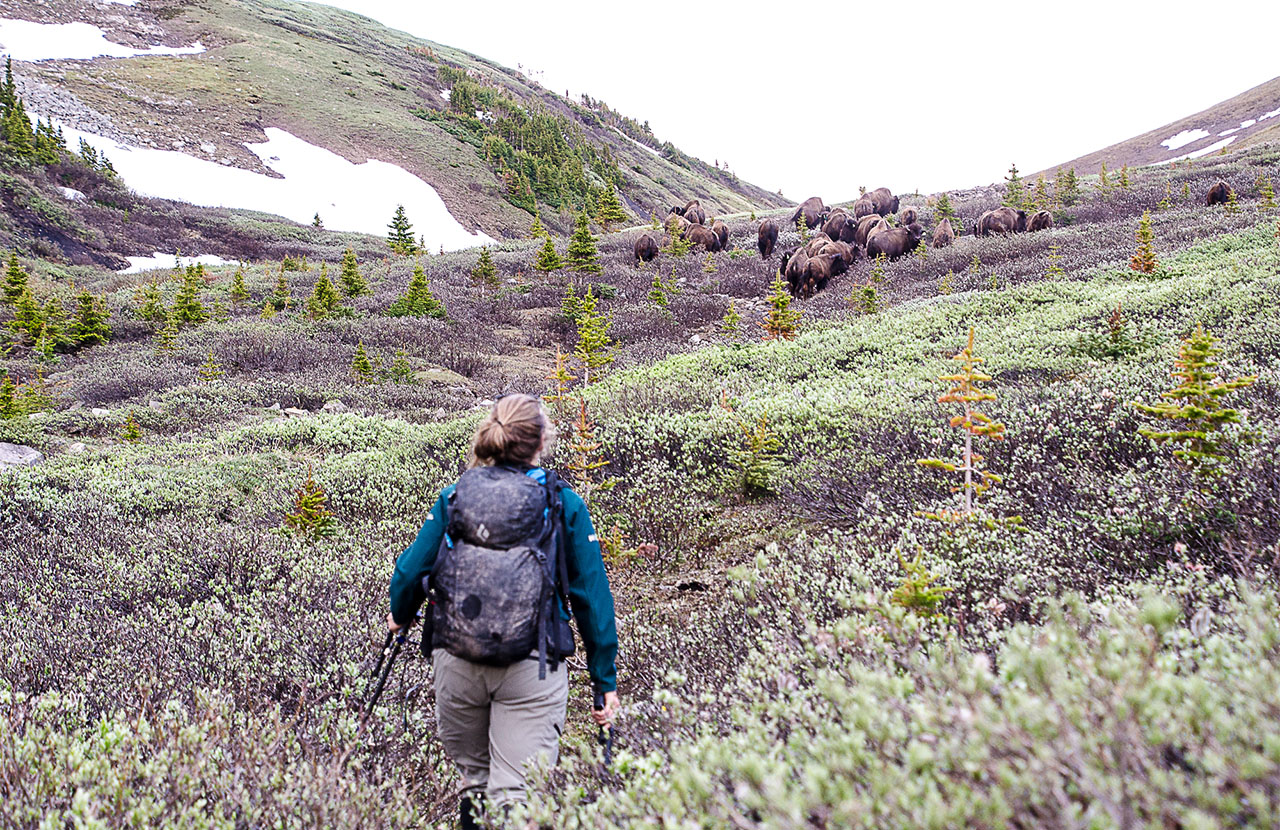
K. Heuer/Parks Canada
In May 2018 the Banff bison reintroduction team travelled to Montana to learn how to conduct low-stress herding. Now that the bison are roaming free, we’re applying what we learned from our American neighbours to Banff. Each time we herd the bison, we record what we did and how the GPS-collared bison respond for 24 hours afterwards. So far, we’ve found that low-stress methods are very useful in getting the bison to move in the direction we want. How long the animals stay where we leave them, however, changes with different settings like bison group size and even wind direction.
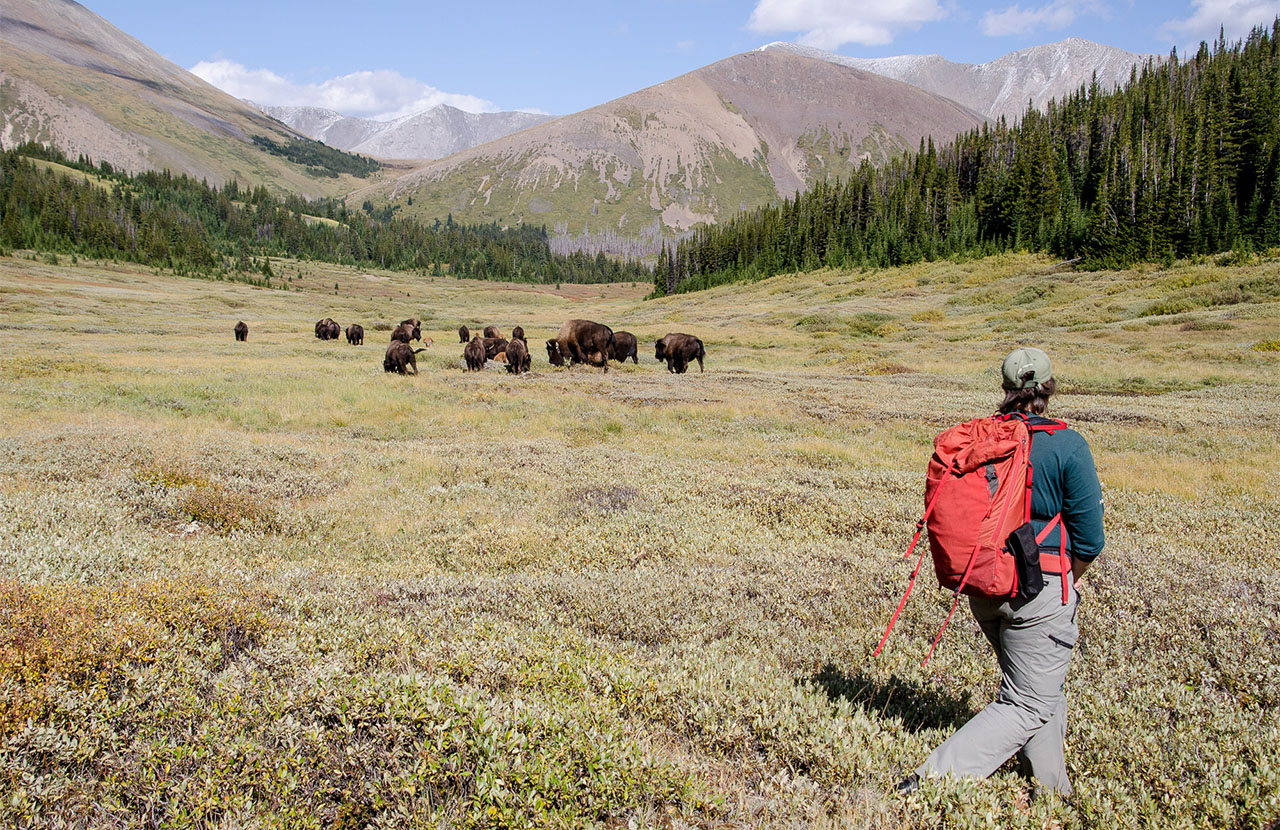
K. Heuer/Parks Canada
Herding bison in the remote, rugged backcountry of Banff National Park has its challenges and we need to be flexible. For example, sometimes we start moving the animals from high mountain areas using a helicopter, and then change to herding by foot or horseback once the herd easier ground in the valley-bottom.
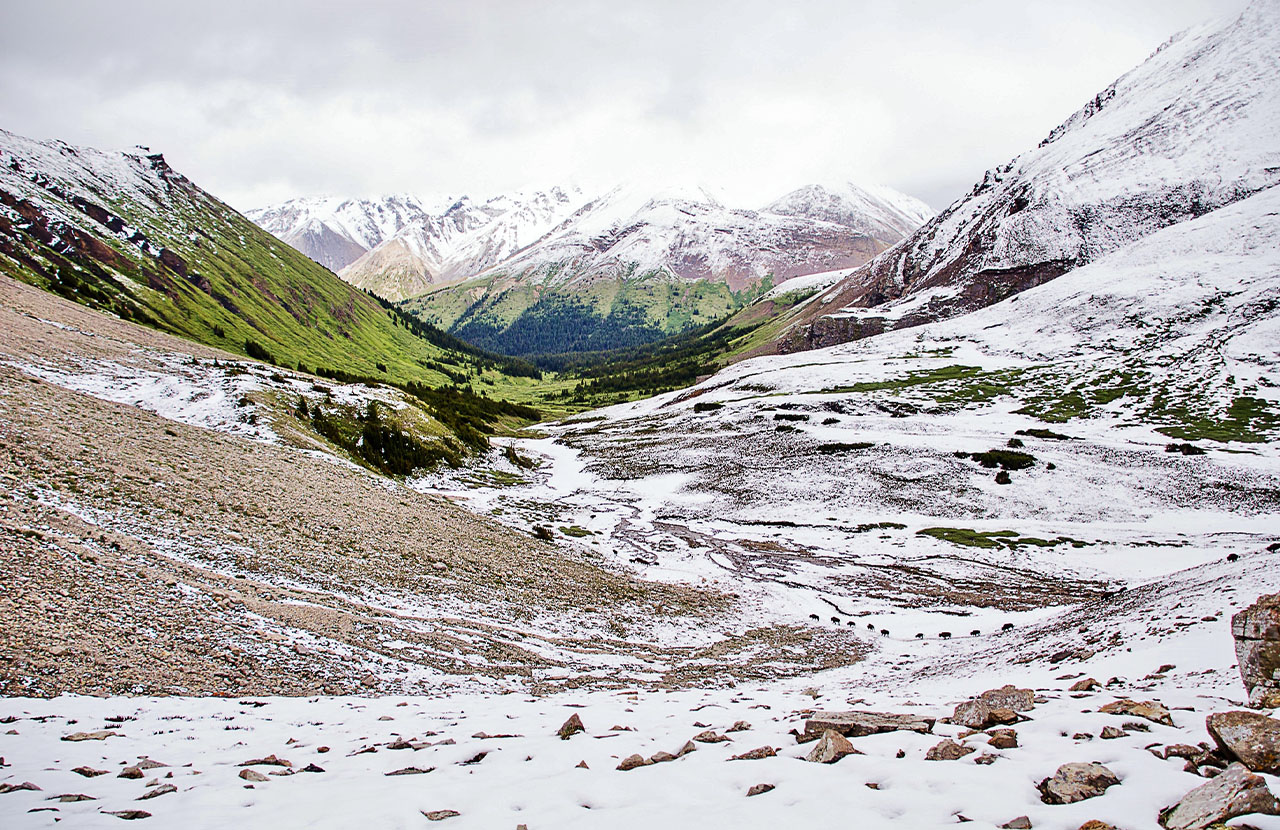
K. Heuer/Parks Canada
Each day is different when you work with wild animals! By being adaptable and respectful, we’re finding that low-stress herding is a valuable tool to help #Banffbison connect to their new home range.
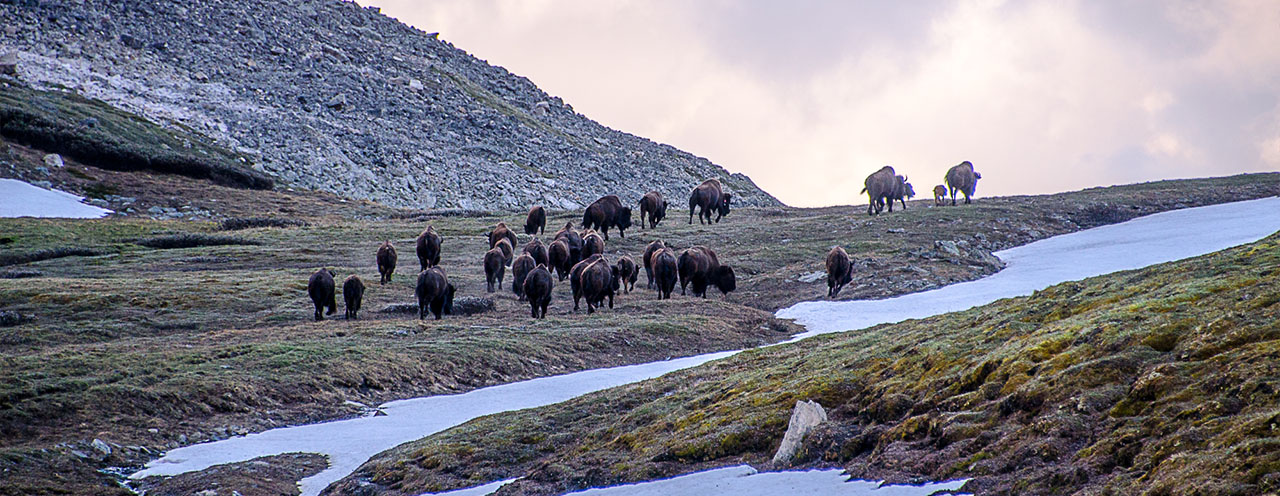
K. Heuer/Parks Canada
-
October 26, 2020: Radio Collaring Wild Bison
October 26, 2020: Radio Collaring Wild Bison
Bison are hard on radio collars. They love to rub and scratch against trees and rocks, to roll and wallow in the dirt, and to tussle and wrestle with each other. This rough-and-tumble lifestyle has led to all 14 radio collars (fitted to bison prior to their release) breaking-off over the last two years.
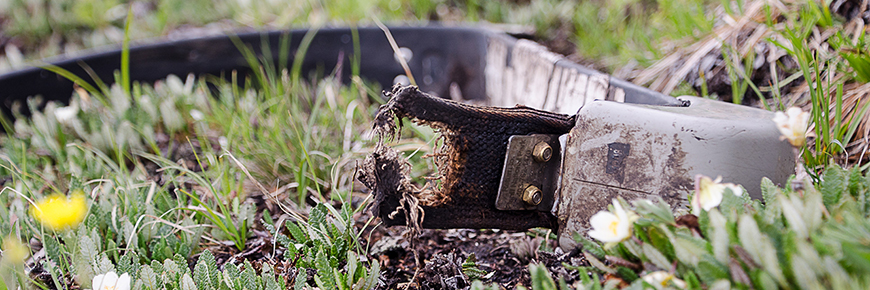
A bison radio collar, originally deployed in spring 2018, found dropped on a high ridge in summer 2019. (K. Heuer/Parks Canada)
We’ve worked with the manufacturer to strengthen the collars, and figured out a better way to attach them, but the biggest challenge is getting them back on animals that are now wild. Collaring bison while they were still in the fenced soft release pasture was difficult enough (see April 2018 blog); now our bison have been roaming Banff’s remote backcountry for the last two years.
After much pondering last winter, we did what many other national parks with bison do: we contracted a specialized wildlife capture crew last January. Within an hour of starting, they swooped over the herd in a small helicopter, threw nets over two of the cows, then quickly collared and released them, unharmed.
It’s a quick and efficient method, but the movements of the freshly collared animals over the next two days concerned us: instead of the usual winter patterns of bison hunkering down in lowland meadows, the two collared cows moved erratically upslope, into deep swaths of forest, and, atypically, in opposite directions. It took several days for them to settle and rejoin the herd.
This year we yearned to find a better way. With more animals to collar to ensure we reach our target of at least 10% of the herd radio collared in the initial years of the project, we decided to try a completely different approach this fall: darting and radio collaring bison from horseback.
If you’re imagining one of those crazy 1800s Charlie Russel paintings of horse-mounted archers galloping beside stampeding bison, then think again. Our approach is exactly the opposite: slow, steady, measured and quiet. If everything comes together and we are patient enough, we can approach and fire a dart from the saddle while most of the bison remain bedded.
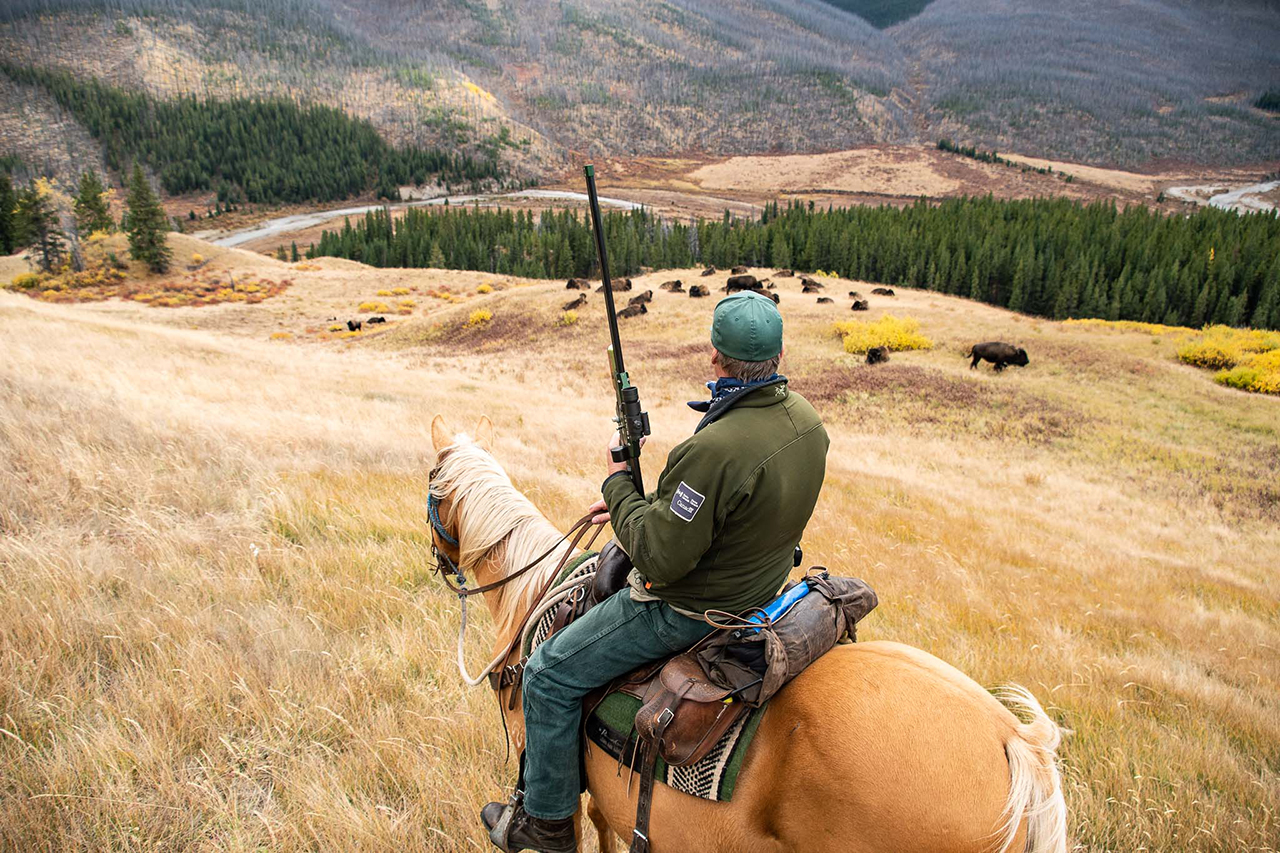
A slow, steady approach with dart gun at the ready. (K. Heuer/Parks Canada).
There’s always a bit of a commotion once the dart goes in, and it takes some effort to haze curious herdmates away from the darted animal as it falls asleep, but the rest of the operation is calm. With our horses tied up and the other bison quietly milling around us, we approach on foot, put on the blindfold, check vitals, administer oxygen, remove the dart, fit a new radio collar, collect hair and blood, and inject the reversal drugs. Minutes after the reversal goes in the animal is up, reunited with its calf, and back with the rest of the herd.
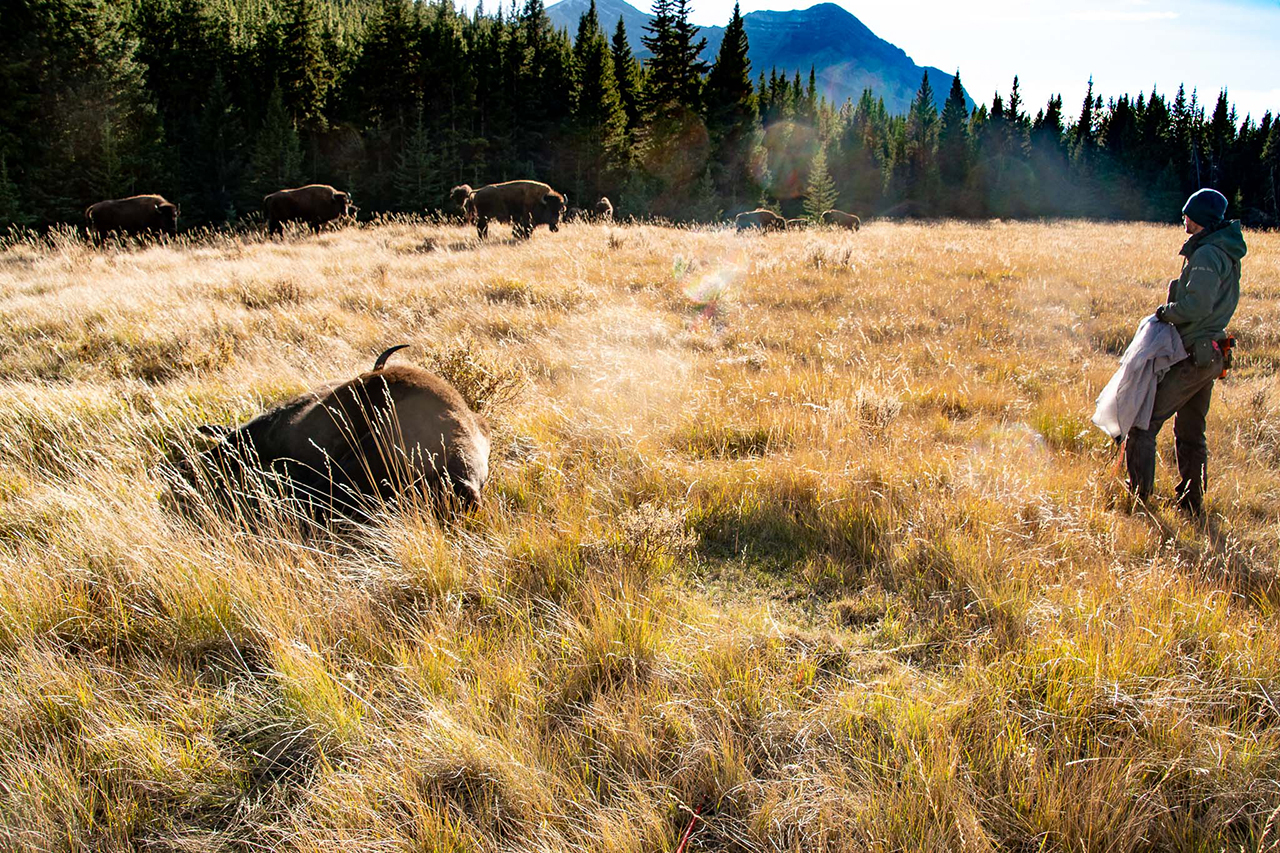
A darted bison goes to sleep as the rest of the herd mills around. (K. Heuer/Parks Canada).
The best part is what doesn’t happen afterwards. No big, erratic movements. No odd solitary behaviour. Sometimes the herd stays and feeds in the same meadow for another few days.
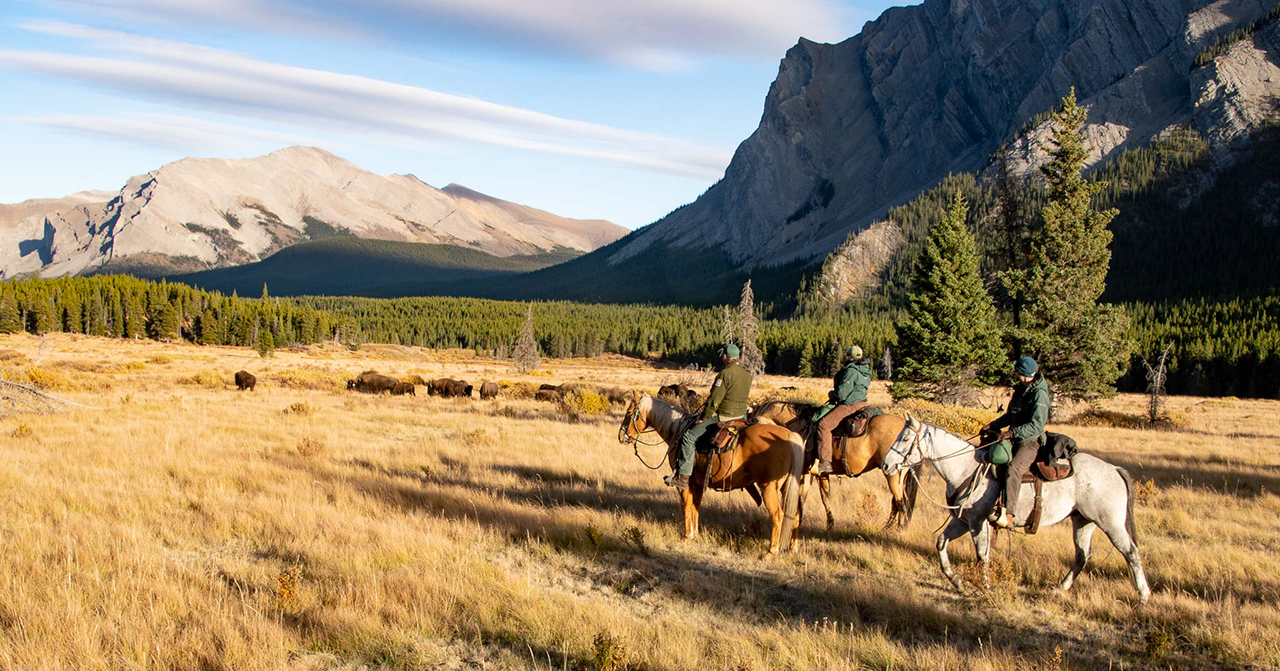
The Parks Canada capture team departs the meadow where bison remain after being radio collared in the previous hours. (K. Heuer/Parks Canada).
Parks Canada’s carefully evaluates risks and benefits before undertaking any capture/collaring activities and we always follow the highest standards of animal care. We also strive to learn and refine our techniques to further reduce stress on the animals. On that front, radio collaring bison from horseback shows promise!
-
August 18, 2020: Of Wolves and Bison
August 18, 2020: Of Wolves and Bison
A lot of people agree that Banff National Park’s recently reintroduced plains bison are pretty special but did you know they are one of just five populations in North America that coexist with their major predator, the wolf?
Wolves generally take down sick and weak animals which is sad for the target animal, but this predation pressure improves the health of bison over time. Indeed, such pressure is what has shaped bison to be the tough, fast, formidable and beautiful wild animals that we admire today.
As the famous conservationist, Aldo Leopold, said about this dance between predator and prey, “Where would the deer be without the wolf to have whittled its leg?”
So when will wolves start “whittling” at Banff’s reintroduced bison? The short answer is we don’t know but we can look at what’s happened elsewhere. Over 20 years passed before wolves learned to hunt reintroduced bison in the Yukon. Meanwhile, only 2 years passed before reintroduced wolves in Yellowstone made their first bison kill.
Back in Banff, the two species have definitely been sizing each other up since we released the bison herd in July 2018 but we have yet to record a kill. In an animation of radio collar locations shortly after the release you can see how the main bison herd (represented in blue) uses the same meadow for more than two weeks despite multiple approaches by a radio collared wolf (represented in yellow).

The opposite has been happening too: a set of recent images from one of our remote cameras in the Panther Valley shows a brash and curious teenage bison bull pursuing two wolves! Another sequence from earlier this winter shows the main bison herd and wolves walking a trail at night within minutes of each other in both directions. This chill attitude is all the more amazing given these bison didn’t know what wolves were before we translocated them from wolf-free Elk Island National Park three years ago!

How long before all this polite sniffing gives way to something more serious? How long before the age-old dance between predator and prey resumes?
We’ll be watching and will share what we learn.
-
February 14, 2020: Banff's First Wild Bison Death in 140+ Years
February 14, 2020: Banff's First Wild Bison Death in 140+ Years
We knew it was going to happen eventually: one of Banff’s bison has gone missing and, given its young age, we expect it died of natural causes.
Back in late September, one of our staff noticed one of two bison calves born in the wild this past June was no longer with its mother and the rest of the main herd. Meanwhile, a smaller, much fuzzier and reddish calf was sticking close to another cow. Back in the office, a report was filed: one calf lost, another calf just born.
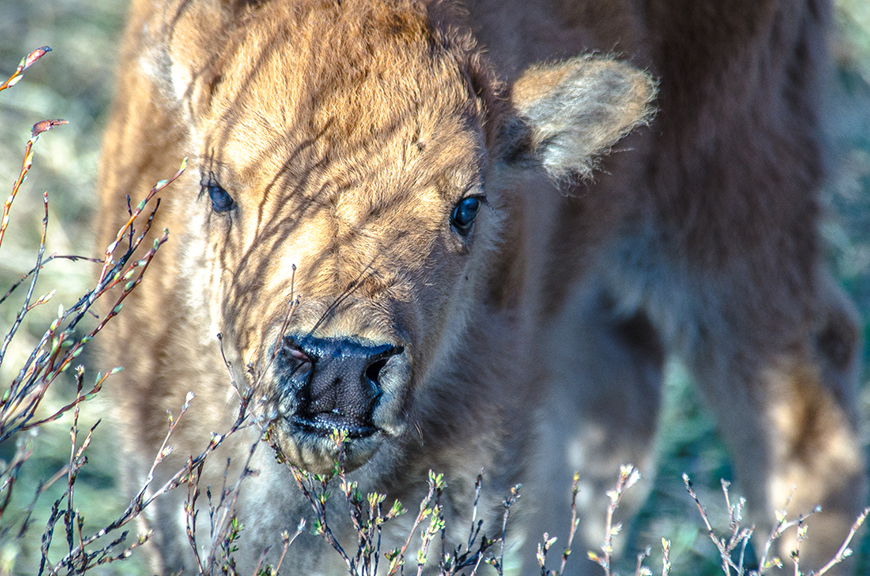
K Heuer / Parks Canada
More than a month passed before staff could train binoculars on the increasingly elusive herd and corroborate the observation. A few weeks later, images from one of our remote cameras confirmed the situation.
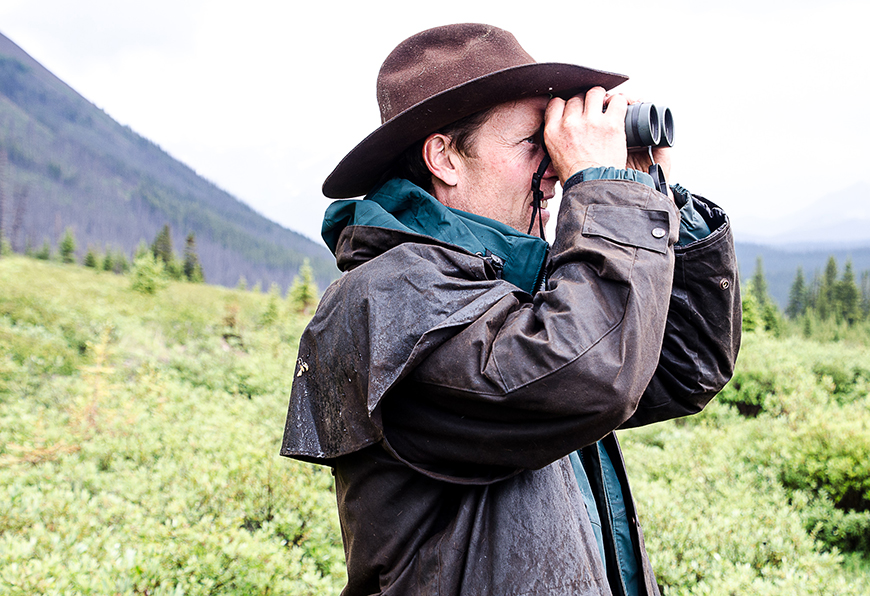
K Heuer / Parks Canada
What became of the missing calf? As scientists and conservation staff overseeing the reintroduction project, we’d love to know exactly what happened, but the vastness of the 1200 km2 reintroduction zone, coupled with the increasing wildness of the herd (the missing calf’s mother is not radio collared) means we probably never will. This is simply an example of nature taking its course within a healthy ecosystem. The calf may have died from a predation event, succumbed to an injury or simply died in this harsh mountain environment through exposure to many natural hazards including severe weather, steep terrain and challenging stream crossings.
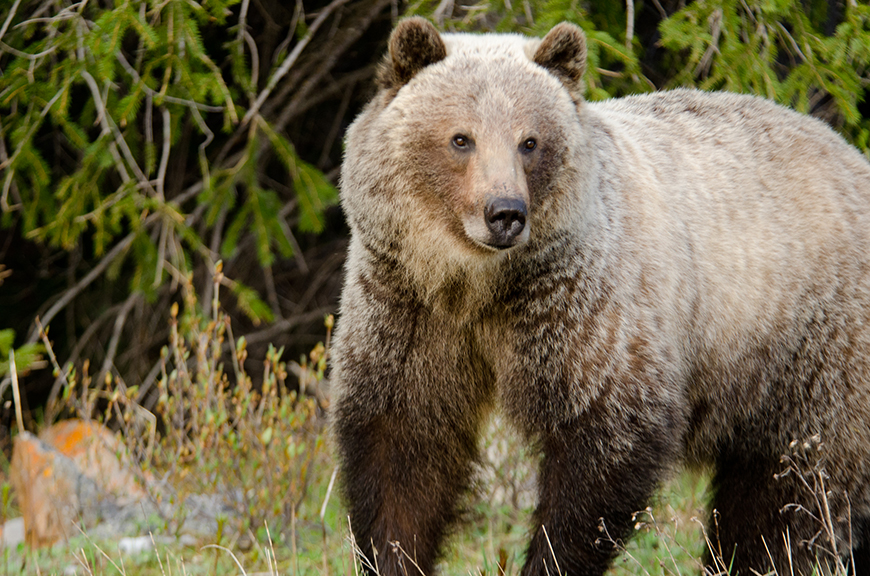
K Heuer / Parks Canada
What we do know is that nature wastes nothing and this first natural bison death in over 140 years will be a gain for the ecosystem of Banff National Park. Dozens of scavengers, including pine martens, ravens, voles, coyotes, beetles - and maybe even a wolverine or bear – will have already converted a new but ancient kind of meat, sinew and bone into their own muscles and perhaps even growing fetuses. And next spring the grass will be a little lusher where the bison died and the birds will be a little more active, swooping down for the insects that will still be cleaning up the site, and salvaging the remaining tufts of bison hair which the birds will use to line their nests.
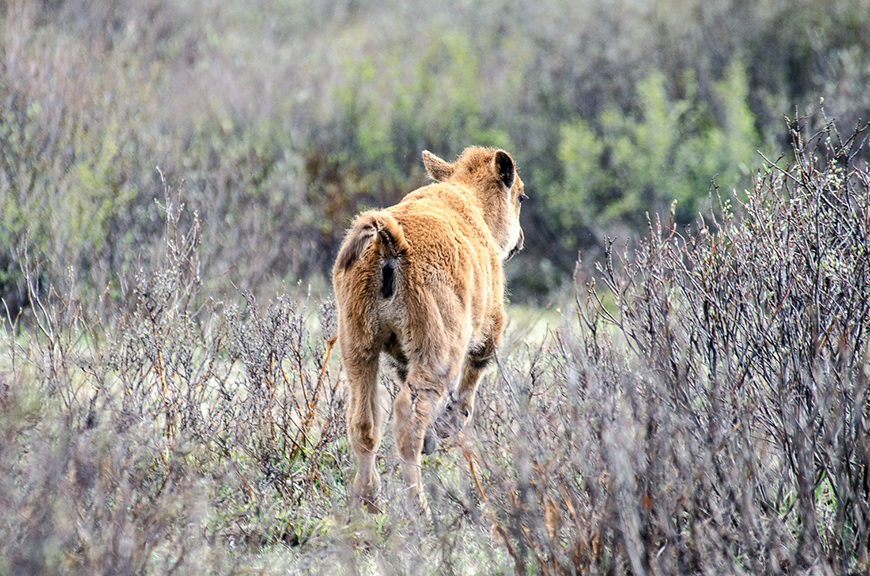
K Heuer / Parks Canada
Although sad, this first bison death is an indication of success for the reintroduction project; Parks Canada’s goal, from the beginning, has been to restore the missing roles and relationships of bison within the ecosystem, not just bring back a missing animal.
Looking at it from this perspective, the calf still lives.
-
December 3, 2019: Where High-Tech Meets Wilderness – 4 Ways Parks Canada Learns from the Herd
December 3, 2019: Where High-Tech Meets Wilderness – 4 Ways Parks Canada Learns from the Herd
The return of bison to Banff National Park is an exciting experiment in a giant natural laboratory. To observe the herd as they reintegrate into the ecosystem, our scientists use remote technology that allows us to collect information without disturbing the animals. Here are some of the tools we use to monitor the herd and what the research reveals.
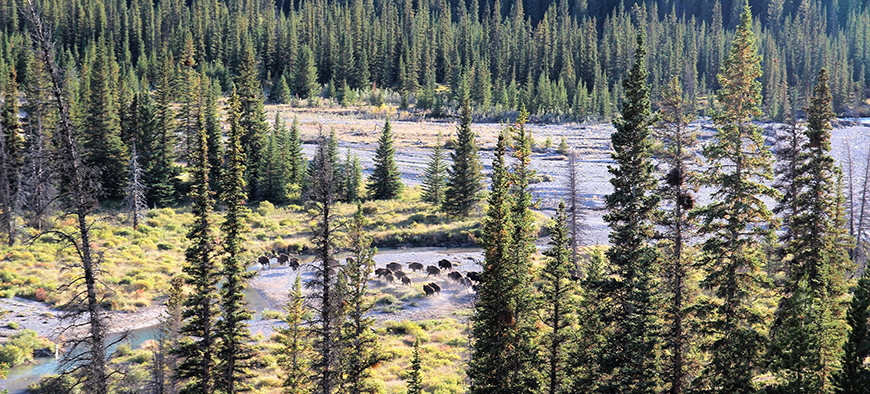
1 – Herd tracking
We rely on GPS radio collars as our most essential tool to monitor herd movements. Before we released the herd into the wild, we collared all the adults . The collars beam location information via satellites to a web platform that our team can access from the office.

The collar data tells us about how the animals adapt to their new home and the type of habitat they prefer. We closely observe which animals travel together, and for the most part, they have all been travelling as a large group with some side adventures along the way.
The collars give us insight into how bison interact with other species. For a few months, we watched with curiosity as collared wolves came to investigate and the bison stood their ground. Unfortunately, we only observed a few interactions before the wolves ventured outside of the park boundaries where they were legally trapped and killed. We also recently collared 10 bighorn sheep within ‘bison country’ to gather information about how bison affect sheep movements and habitat use.
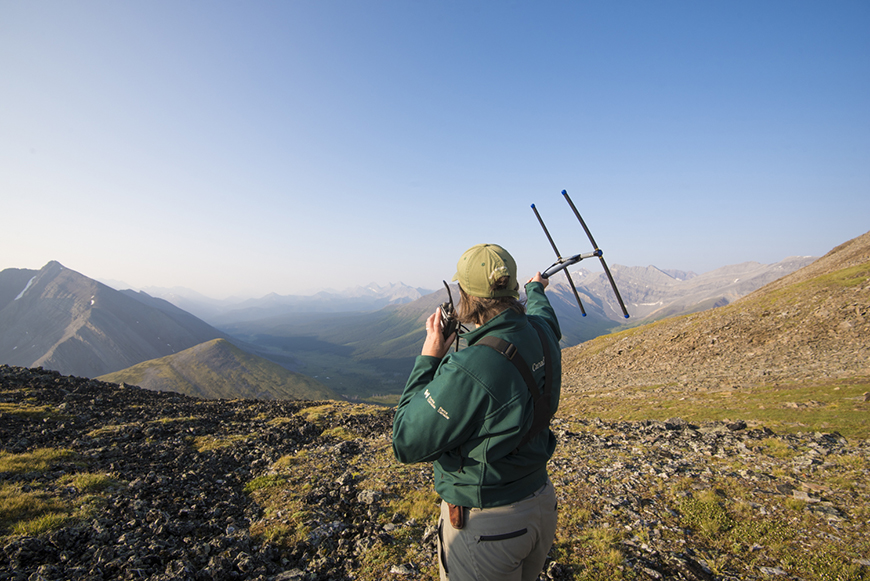
Collars allow us to pinpoint the location of the herd when we are in the field. Our scientists use a radio telemetry receiver to pick up the unique signal of each collar. Then, they can approach the herd from a safe distance to record data on behaviour, herd health and number of animals.
Unfortunately, the collars have a limited lifespan, and many of the original collars have naturally dropped off - leaving 6 operational collars. We plan to recollar at least 3 animals this winter to maintain the vital flow of data about the herd.
2 - Remote cameras
Banff’s bison travel through rugged country that is difficult to access, and they are sensitive to human presence. That is where another important piece of technology comes in: remote cameras.
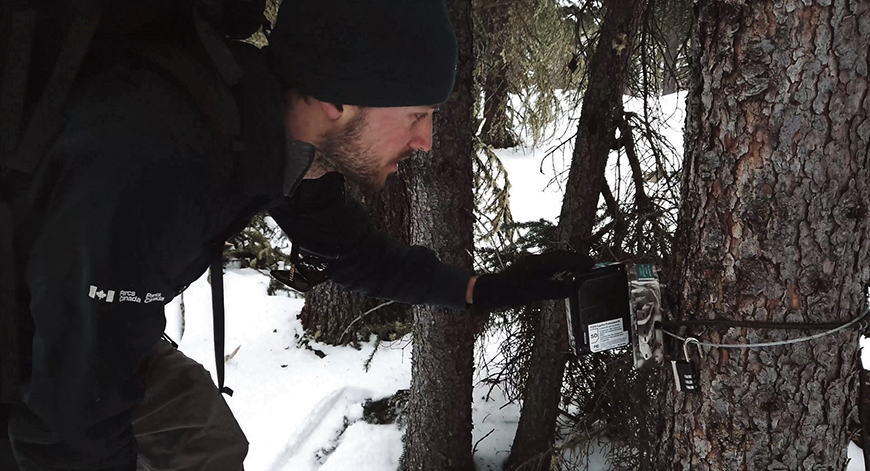
Our network of remote cameras captures the secret life of the herd. We set them up along trails we know the animals use. When an animal passes by, it triggers a sensor and captures a photo or video.
Images from remote cameras reveal information that would be difficult to observe in person, such as detailed health observations. Remote cameras also capture some special moments that would otherwise go unseen, like this photo of three generations of the herd all in one frame.
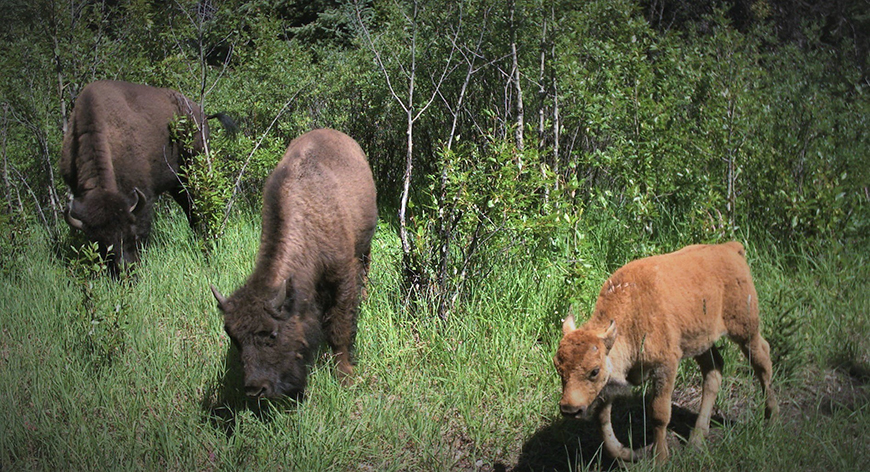
3- Scat sampling
Wherever bison roam they leave behind bison dung, a stinky but important clue that tells us what they are eating. As part of a long-term monitoring program, our scientists collect dung samples from the field. We analyze the samples in the lab to track the types of plants the bison have been eating. The data helps us learn about the Banff bison diet and the type of habitat they need to thrive.
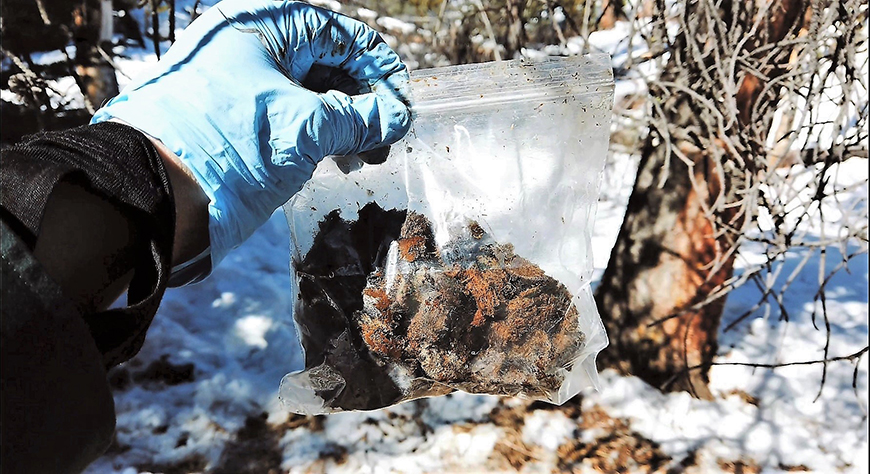
4 - Bird monitoring
If you see a bird soaring above you in some of Banff’s most remote valleys, a bison may have helped raise it! Birds and bison have a special relationship. Some birds, like the Brown Headed Cowbird, co-evolved with bison to pluck bugs from their back. Others, like the Olive-sided Flycatcher, use fuzzy bison wool to line their nests. Bison also increase grassland habitat that benefits meadow-loving birds.
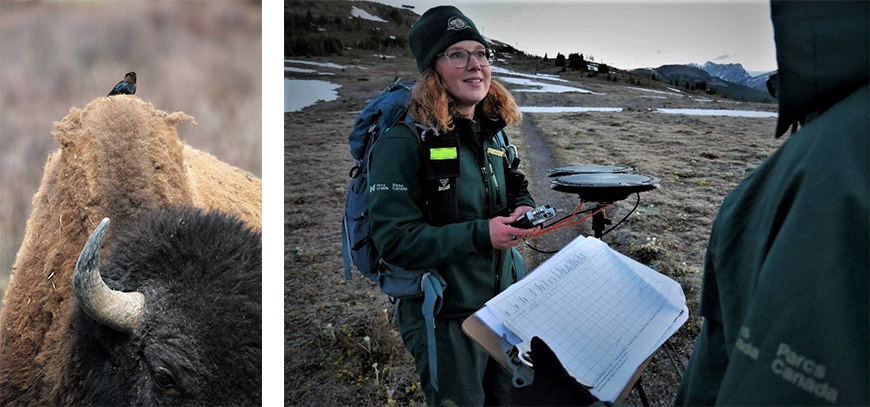
To assess the effects of bison on birds, we monitor bird populations both inside and nearby the bison reintroduction zone. By recording birdsong in the same places each spring, we track changes in species diversity and distribution. This non-invasive method gives us a greater understanding of the cascading impacts of returning a keystone species to the ecosystem.
Our research in the backcountry of Banff National Park is on the leading edge of conservation science. As one of only 8 wild herds in North America, what we learn from the Banff bison herd benefits the broader world of bison conservation.
See this conservation work in action on our 5-part YouTube webseries that won the 2019 Travel Alberta Tourism Content Award.
-
November 2, 2019 – Walking with the Bison
November 2, 2019 – Walking with the Bison
Indigenous peoples have a historical and cultural relationship with bison that spans thousands of years. The reintroduction of bison to Banff National Park fosters reconnection of this important relationship, inspires discovery, and provides stewardship and learning opportunities. In summer 2019, Parks Canada led a group of youth filmmakers from Treaty 7 though the remote Red Deer Valley where bison roam once again. In partnership with the Banff Centre, these filmmakers from the Nakoda A/V Club and the Napi Collective created short films inspired by their experience. This guest blog, written by Amber Twoyoungmen of the Nakoda A/V Club talks about the ‘making of’ and the significance of the return of bison to Treaty 7 Territory.
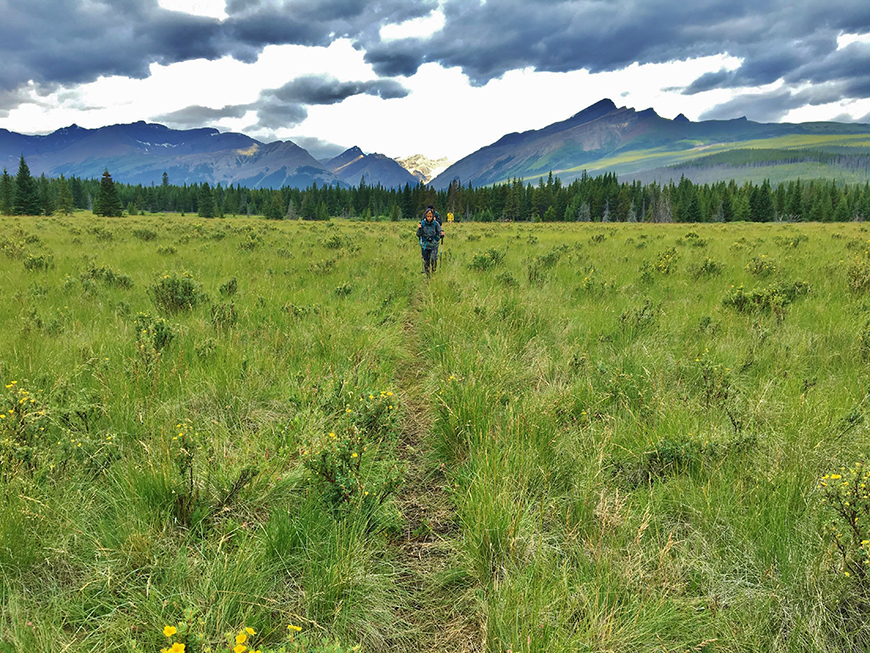
The Nakoda A/V Club is a group of young emerging Indigenous artists from the Bow Valley making films and animations about narratives that matter to us. We work together to help each other to get through tough times and to create opportunities for each other to express our stories.
In the fall of 2018 we learned about the Bison being reintroduced in Banff National Park. We saw the films that Parks Canada made about the project, and we thought about what we could add to the story.

Bison matter to Nakoda because they were always part of this place. They belong here. Their presence is part of the Bow Valley, just as the presence of people is. At one time, Banff was understood by my people as a place of gathering, of trade, and of healing. Today its meaning is different, but I’m excited, because it seems like people nowadays are thinking carefully about all the beings in this Valley and how they relate to each other.
We asked Parks Canada if we could help tell the story of the return of bison, and we were so happy they agreed! We invited out our neighbors, the Napi Collective from the Siksika Nation to tell stories too, because they belong here also. We gathered at Banff Centre to think about the stories we wanted to tell, and to learn about Bison. Some of our members, got to go to the Red Deer Valley, where the Bison live! When they came back, they told us about what is was like, and they’ll tell you too:
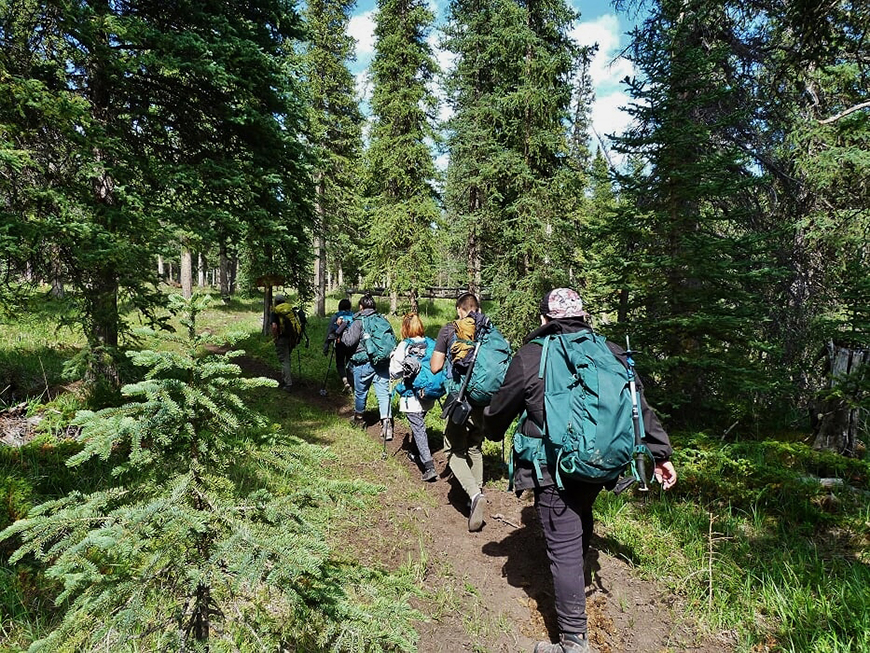
Javan Twoyoungmen: “Being invited out to the backcountry of the Rocky Mountains was an incredible experience....The Rockies hold a precious history with the Nakoda people, walking the path my ancestors once took was a memorable experience one that I will never forget”.
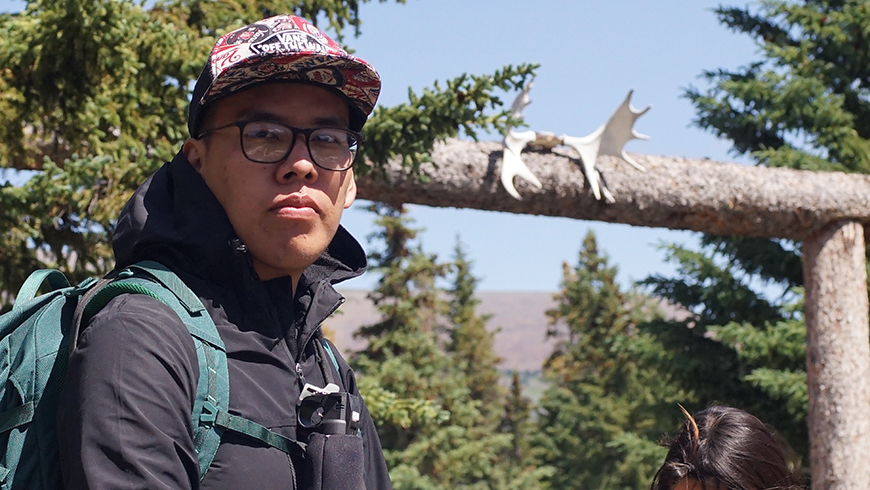
Iris Clarke: “I can honestly say it was the hardest thing I’ve ever done in my life. I didn't think I could hike that far. But it was the most rewarding too”.
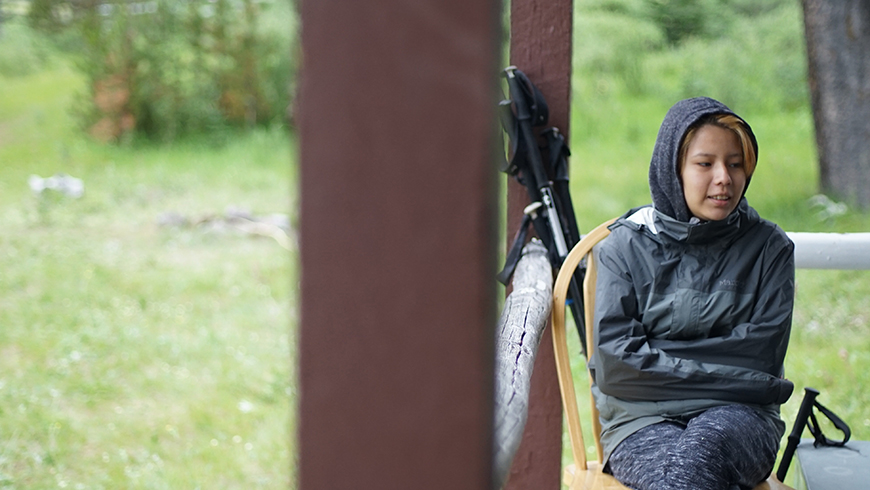
Tashina Ear: “My experience hiking with the Parks Canada crew was very exciting but most of all, a great opportunity to learn with Parks Canada. Those very paths were also the same trails our Nakoda ancestors had walked through and I’ve never realized how hard they worked, and how long their days must have been. Our ancestors were so strong, and I want to be like them. I’ve been on simple little two-hour hikes but nothing compared to this! I’m greatly appreciative that I was given this opportunity to hike with Nakoda A/V Club members and the staff from Parks Canada”.
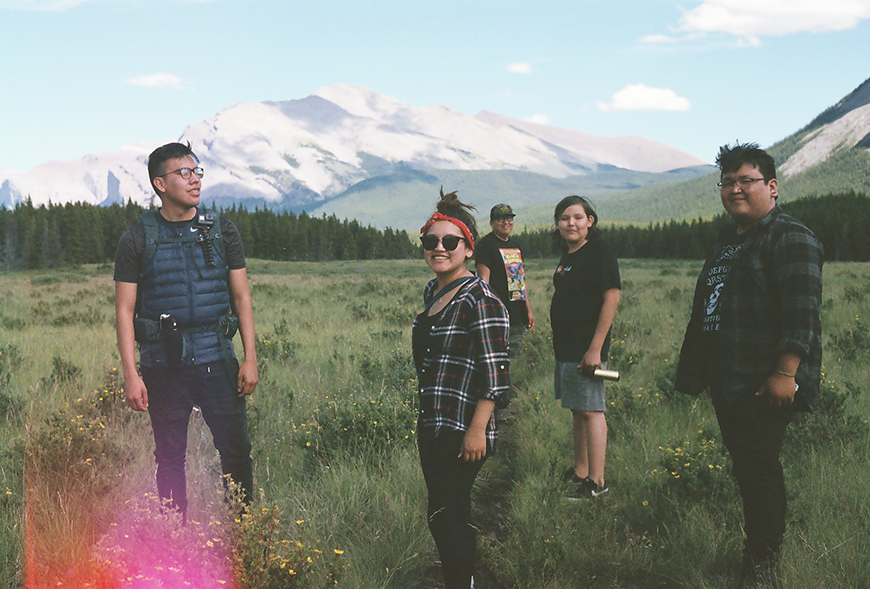
After the hike, we made a movie. We used everything we learned, and everything we thought about to help tell the story we wanted to tell. As part of making that movie, we camped together, we hiked, we swam, and we went back to Banff to edit our work with the support of Banff Centre. Then we will be able to present what we made and what we learned as part of the Banff Mountain Film Festival.
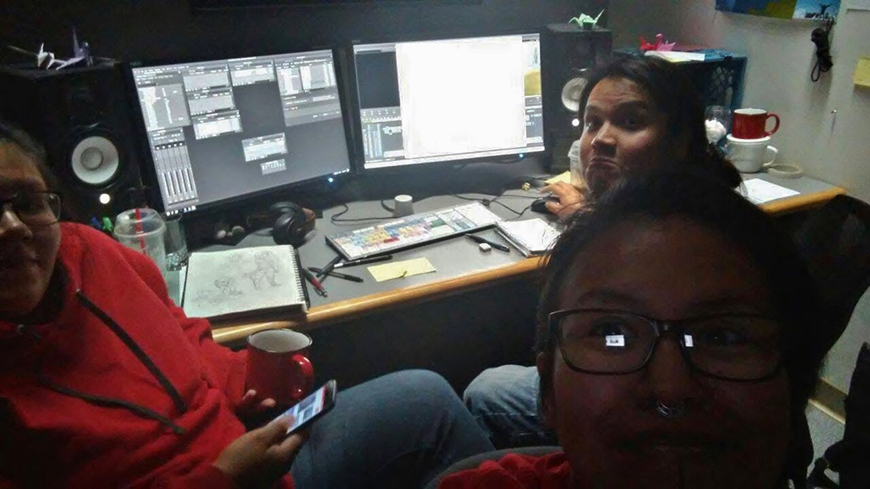
The project was such a great opportunity. Bison matter not just to us but also to lots of beings in the mountains. Parks Canada taught us about how Bison leave fur for nests, make indents for pools of water to grow, and help to create conditions for grasses to thrive. At one time, I might have learned this by watching the Bison here in the Bow Valley, and I’m sad that’s not the case anymore, but I’m so excited that some of our members did get to learn this way by hiking in the Red Deer Valley! That's a connection to who we used to be, and who we might be again someday. In the future, our story will include all the new people in the Valley too, just as this part of our story is so intertwined with Parks Canada.

It’s an honor to work on something important. We loved working with Parks Canada to tell the story of the return of bison to Banff. Like all our stories, it’s not meant to have an end, it’s meant to be re-told, and shared often, because in the sharing of stories we bring our gifts to the valley, just like the Bison leaves its fur for all the small birds.
Thank you to guest blog writer, Amber Twoyoungmen and to all of the participating filmmakers for sharing their stories with us.
-
October 1, 2019 – Fall in Bison Country: herd dynamics are heating up
October 1, 2019 – Fall in Bison Country: herd dynamics are heating up
The rut is an exciting time in bison society. For most of the year, females and their young travel in maternal herds, while males generally travel alone or in small bachelor groups. The rut brings everyone together, as bulls rejoin the herd in hopes of competing for cows.
Subtle social relationships between individual bison are often difficult to observe in the wild. Thanks to the small size of the Banff bison herd and our ability to track individuals using GPS collars and remote cameras, we can piece together some of their interactions during this dynamic season.
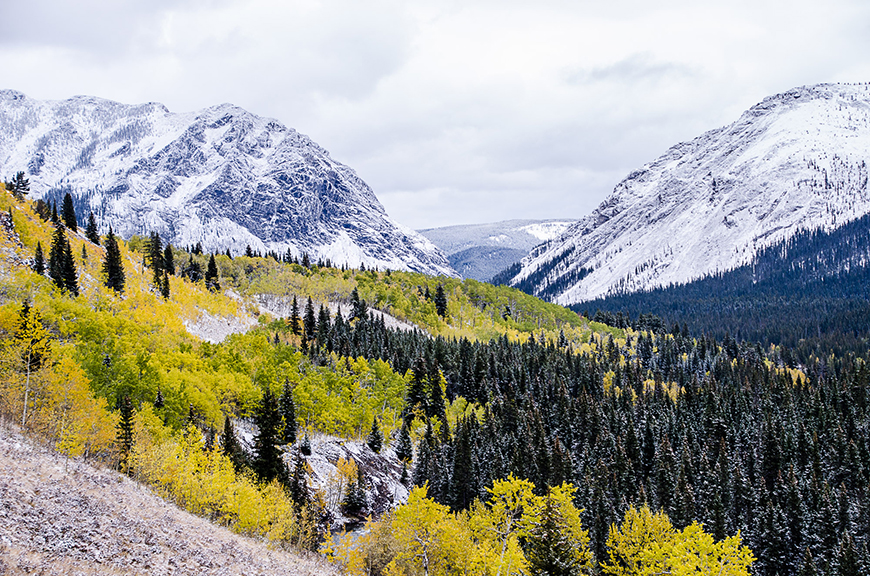
Research suggests that bison may make long-term friendships with other members of the herd, but when hormones are running high during the rut, friendships between bulls are put on hold.
A good example is the shifting relationship between two of the adult bulls with ear tags #2 and #3. Ever since their release into the wild last summer, these bulls travelled together in and around the Panther Valley region of the reintroduction zone. But, after months of peaceful companionship, they were observed aggressively chasing each other earlier this summer.
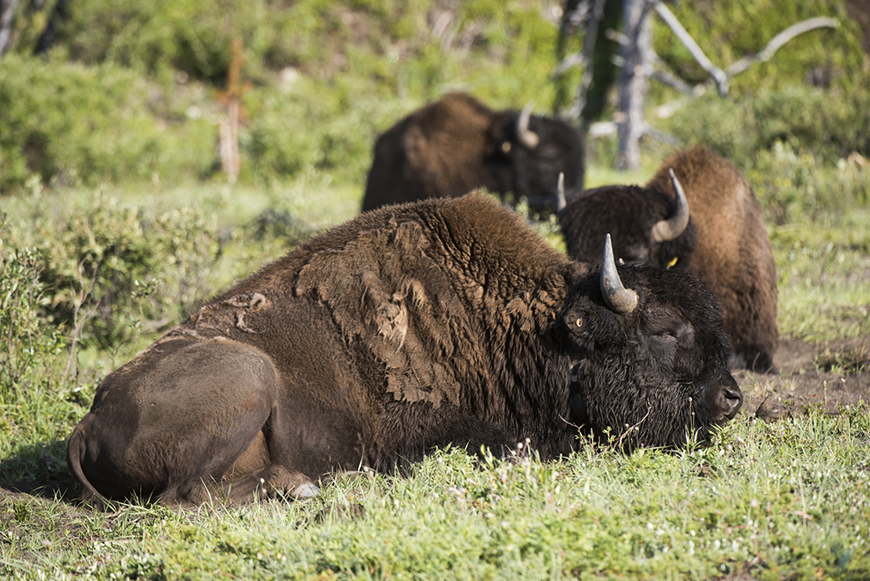
Then, in early August, we received a report from a member of the public of a bison outside of Banff National Park, near the Ya Ha Tinda Ranch. We checked our remote cameras on the edge of the reintroduction zone, and sure enough, Bull #2 was headed east, out of the park. We deployed our conservation team and were able to locate him within two days, by which time he had travelled 60 km away from Banff National Park! Our team safely relocated him to Rocky Mountain House National Historic Site where Parks Canada also manages a small display herd of bison.
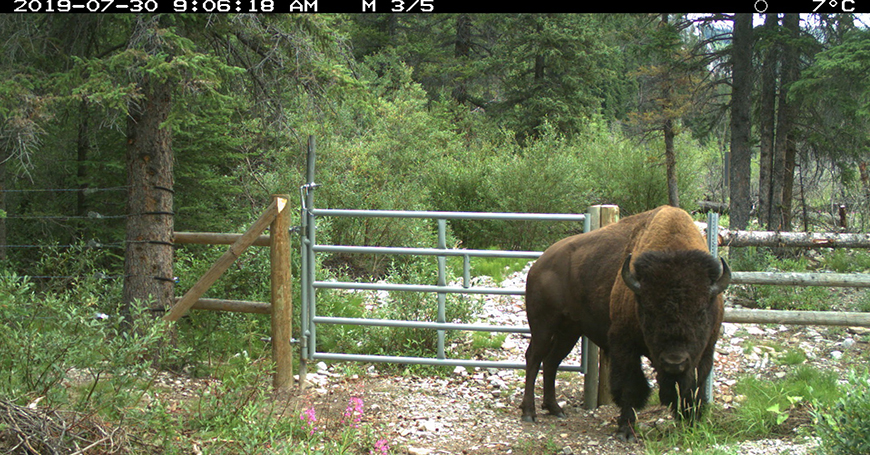
We will never know for sure, but we speculate that he may have been pushed out by a more dominant bull. It is normal behavior for less-dominant bulls to be pressured or to wander willingly in search of other bison where they may meet less competition. Since his move to Rocky Mountain House National Historic Site Bull #2 appears to be integrating well into his new herd.
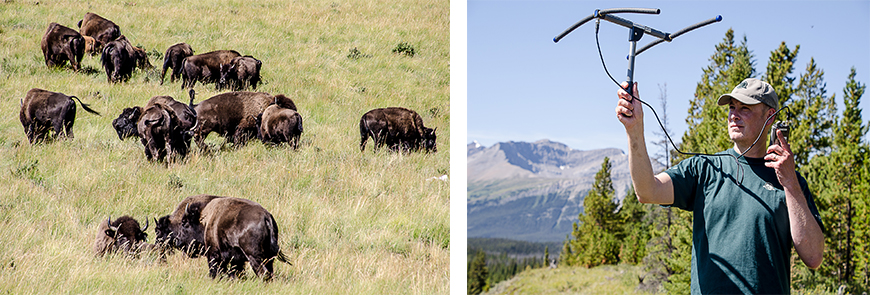
Meanwhile, other hierarchies have been shifting. On a recent trip into the backcountry, our staff observed the main herd grazing in the Red Deer Valley. Everything looked normal…until we noticed the adult bull was different. It was no longer Bull #4 (who had been with the main herd for over a year) but Bull #18 – the lonesome buffalo we wrote about back in February 2018! After a year of self-exile, Bull #18 is making some new friends.

Each season reveals new insights about the Banff herd. Their first full rut in the wild highlights the fascinating power struggles within the herd, as the bison establish a dominance hierarchy. Hopefully, the rut is successful and leads to an influx of new calves next spring to add to the two wild calves we observed so far this season.

We have known the founding herd members for almost three years, and it is a thrill to see their relationships evolve over time. The founding members are already developing a multi-generational herd structure, with new calves frolicking, yearlings gaining confidence, and two-year olds entering breeding age. Our ability to track these herd dynamics on such a fine-scale is a unique privilege in the conservation community. This on-going research deepens our understanding of their evolving behaviours and herd dynamics, and helps support bison restoration in Banff over the long-term.
-
August 2, 2019 – Wild bison, 1 year later
August 2, 2019 – Wild bison, 1 year later
One year ago, we opened the backcountry pasture fence that held the Banff bison herd for 1.5 years, and they took their first steps in the wild. Missing from the landscape for nearly 150 years, bison were free to roam in the hoofsteps of their ancestors across a 1200 km2 reintroduction zone.
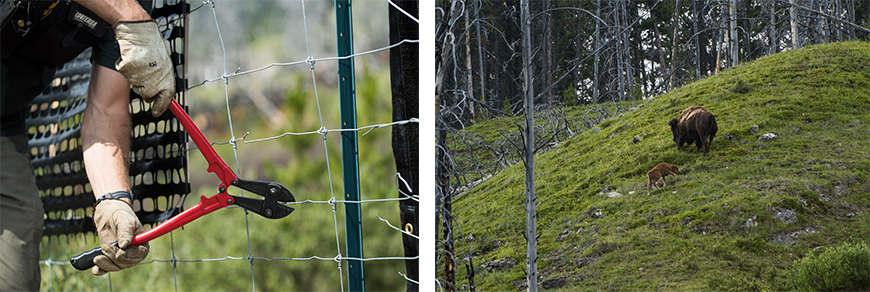
A year later, the herd continues to grow and thrive. Our staff recently spotted 2 wild-born calves, as they ambled across alpine meadows with their mothers. The additions are the first wild calves born and bred in the backcountry of Banff National Park in over a century. They bring the current count of wild bison to 36 animals, and more may join in the coming months.
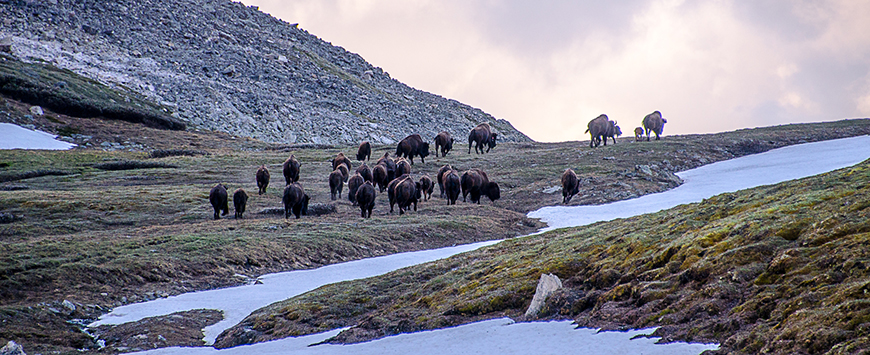
As the snow melts from higher elevations, the herd keeps climbing upwards into the alpine. It is quite a sight to see bison travelling in some of the most rugged and hard to access mountain habitat of Banff’s eastern slopes.
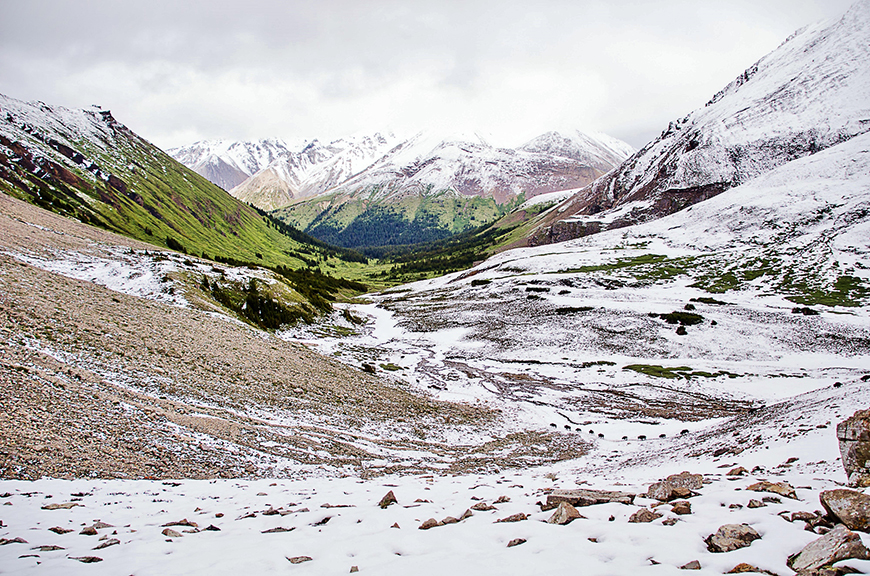
Where will the bison roam with each passing season? Starting this winter, we will be working with researchers from the University of Wyoming to better understand how memory, habitat, fences, and our occasional efforts to herd the animals play a role in shaping their new home range.
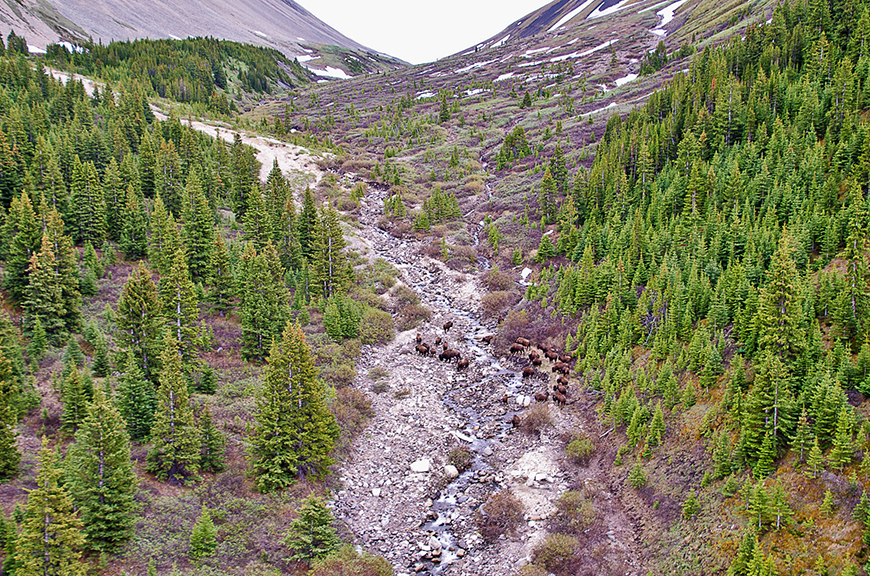
Another collaboration with the University of Calgary will help us monitor the impacts of bison on vegetation, as they graze their way across the landscape, expanding meadows and leaving wallows and nutrient-rich patties in their wake. Each day, we learn something new from these wild wanderers, and we can’t wait to see how much we know by the end of the pilot project in 2022 as a result of our research and monitoring projects.
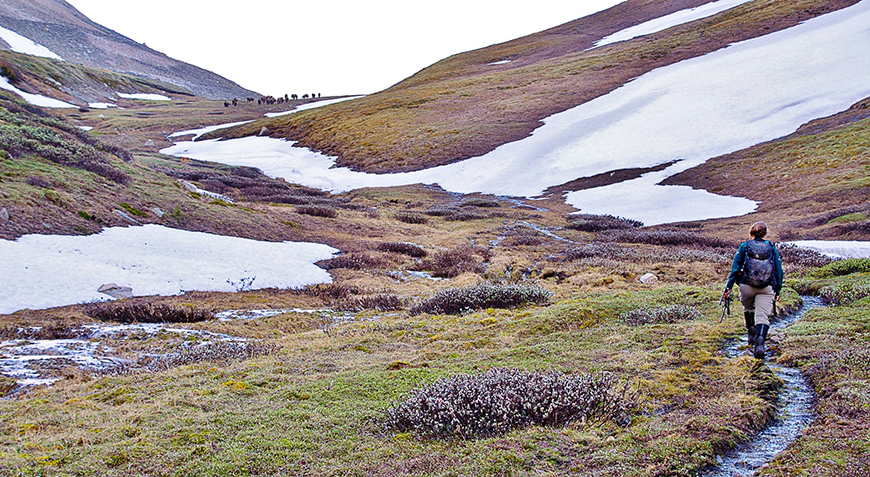
And…if you want to see the behind-the-scenes of what it takes to monitor the herd in the backcountry, we just released the last episode of our backcountry vlog series. Follow our conservation staff as they work restore wild bison in Banff National Park. You can watch the full 5-part series here.
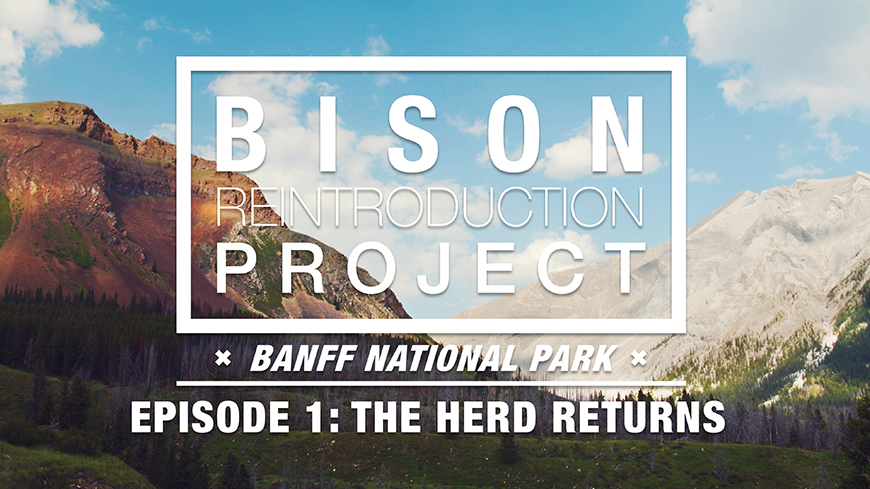
Reintroducing bison to Banff has been a complex and rewarding journey. We have much to learn from the herd and their impact on the landscape over the coming years, as they reintegrate into the ecosystems of some of Banff’s wildest places.
In this moment, Canadians can pause to celebrate this major milestone: after an absence of over 140 years, bison are thriving and making their mark in Canada’s first national park!
-
June 19, 2019: Signs of spring (and bison) in Bison Country!
June 19, 2019: Signs of spring (and bison) in Bison Country!
Spring has arrived in Banff’s bison country. The rich smell of mud and new growth hangs in the air. Birds busily make their nests. Light stretches across the valleys until late in the evening. And the surest sign of spring? Crocuses blooming alongside bison dung!
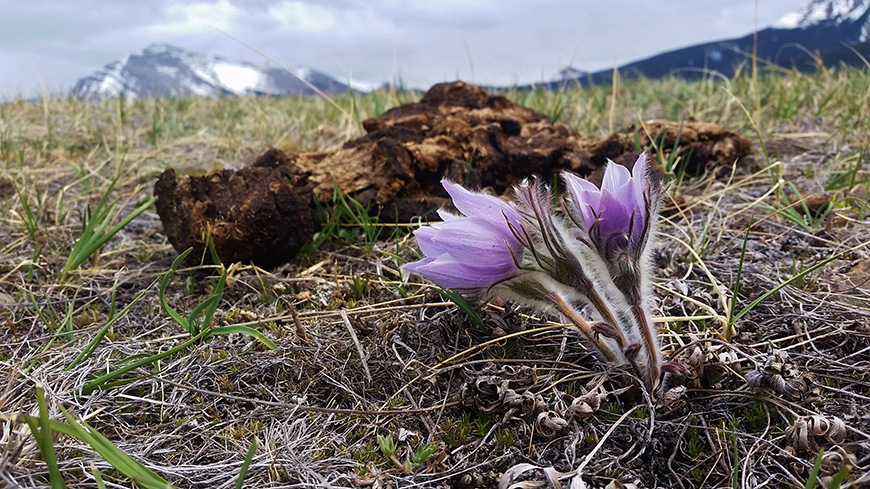
A few months ago the main herd moved north from the Panther Valley into the Red Deer Valley where they settled into low-elevation meadows to graze on new vegetation. They also bumped into the elusivebull #18 who had been travelling solo for the past few months.

As the snow recedes, we are seeing the impact of the newly reintroduced herd on the landscape over the 10 months since their release. The change is so profound that one staff member compared the experience of travelling through the area to being an infant again, seeing an old, familiar place with fresh eyes.

Bison are revitalizing the land with their presence. In some places, bison signs surround you in every direction. The air smells like them: earthy and fragrant. They’ve rubbed against trees, leaving the bark polished. Their fur hangs off branches, soon to be scooped up by passing birds. Their tracks sink deep into the mud.
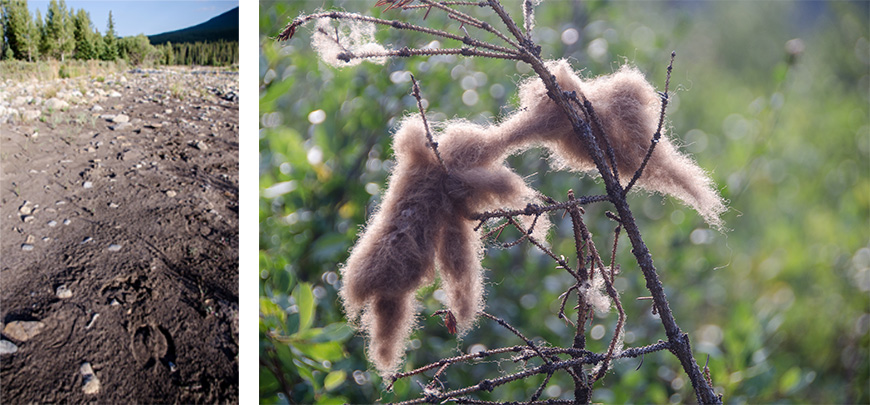
Two of our bison team members recently came upon a meadow in the Red Deer Valley and dropped their jaws in wonder. Ground squirrels chirped and scurried in the newly cropped grass; bison patties buzzed with bug life; a fresh wallow had been carved into the dirt, and, nearby, the bison had grazed back the dead grass to reveal an old bison wallow – likely hundreds, if not thousands, of years old. Ancient relationships, once broken, are now mending.
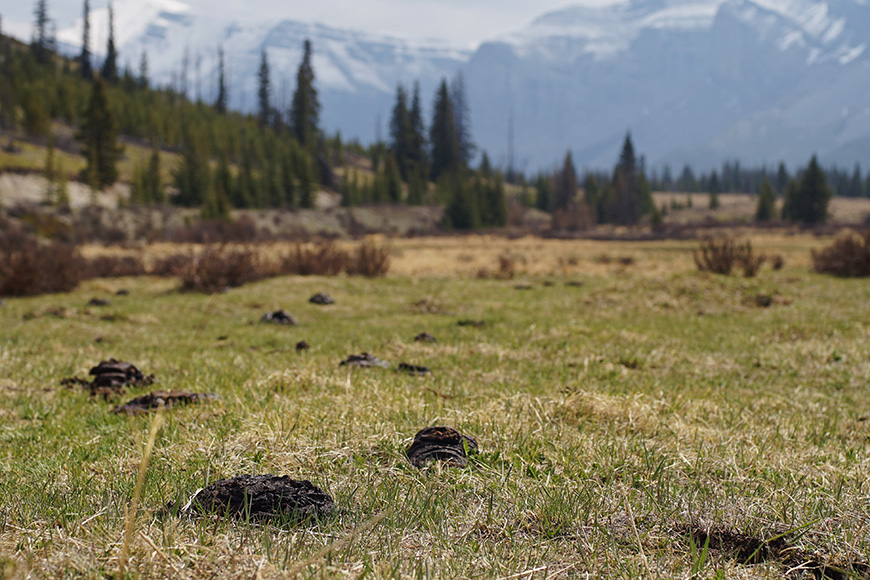
Despite the many obvious signs they leave in their wake, the bison themselves are not always easy to find. They blend in with the brown willow bushes and gray trunks of burned forest, just like the elk, deer, bears and other native species with whom they share their range. In fact, the bison fit in so well it’s as if they never left. Traces of their ancestors are everywhere. It’s quickly becoming apparent that the new trails, new wallows, and - one day - new bones they’re leaving behind aren’t new at all: they are but a thin layer in a deep and ancient story that, thanks to this reintroduction, is once again being retold.

-
April 30, 2019: This old bone - discovering the bison of Banff's past
April 30, 2019: This old bone - discovering the bison of Banff's past
This is the story of a bone. A bone from a bison that lived over 2000 years ago and what it tells us about the history of bison in what is now Banff National Park.
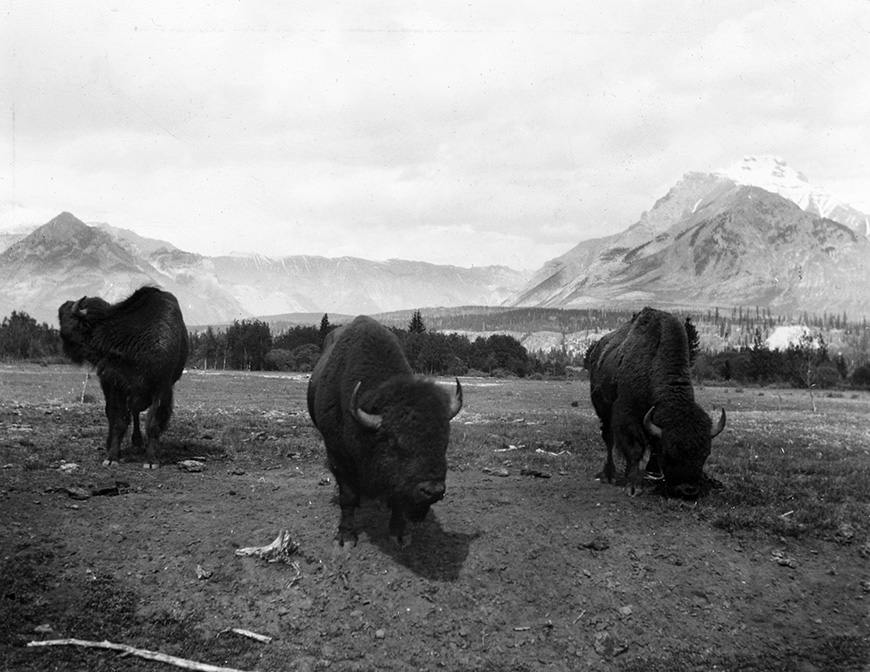
[Buffalo, Banff Animal Paddock], 1896-1905, Whyte Museum of the Canadian Rockies, Moore family fonds (V439/ps-226)
Last spring, water levels were rising quickly in Banff National Park as snow melted and rain fell. Two members of our bison team were walking along the bank of a rushing creek and noticed something strange on a gravel bar: a large bone.
The copper-coloured bone had been exposed by the water and was now at risk of being washed away. The Parks Canada staff recorded the location using a GPS, carefully collected the specimen and brought it to Parks Canada’s Terrestrial Archaeologists. It was not just any old bone… it was an old bison bone.
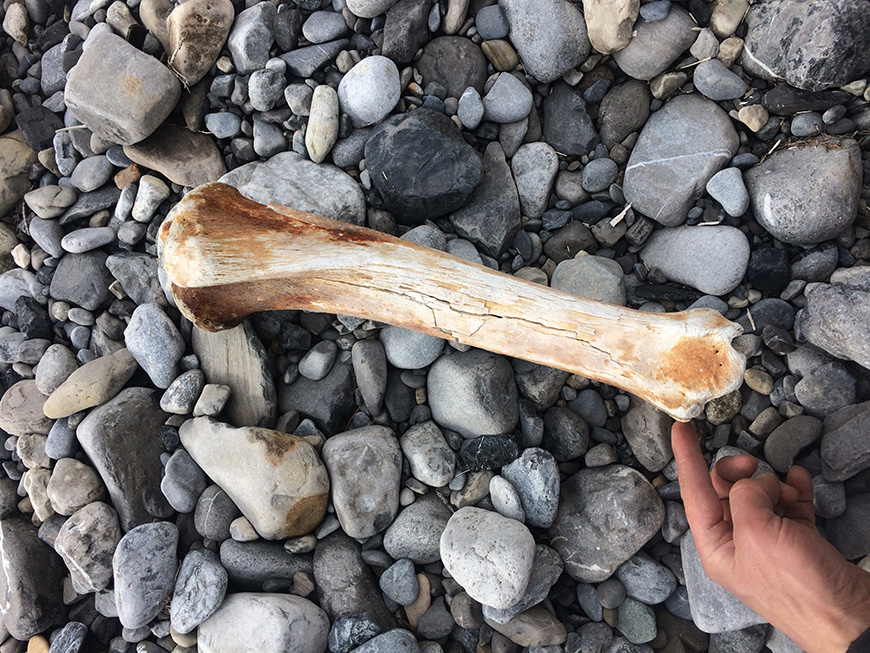
Leave it where you find it. It is illegal to remove cultural or natural objects from national parks and historic sites without a permit. If you come across something that may be of interest, mark the location, take a photo and notify the nearest Parks Canada office.
Once the bone was safely in the hands of the archaeologists in Calgary, they got to work. Here is what they did next to learn more about its story:
- Carefully cleaned the sample.
- Looked closely for signs of cultural modification, like breaks that were made on fresh bone or butchering marks from stone or metal tools. In this case, none were found, indicating that it was not modified by humans.
- Catalogued the specimen.
- Removed a small sample, and sent it to a specialized lab for radiocarbon dating.
- Once at the radiocarbon lab, the technicians powdered the bone sample and used its collagen to date the specimen.

After a few weeks of suspense, the results were in. The bone was over 2100 years old!
It’s not the first old bone found in the park. It joins a growing databank of known sites that contain bison in Banff National Park.
Some of the earliest bison finds are in the Lake Minnewanka area – dating back over 10,000 years. Others, have been found at high elevations, like the 2000 m Elkhorn pass, which is located within the bison reintroduction zone. Bison are present throughout Banff’s archaeological record, but never in the large numbers found in sites in the plains.
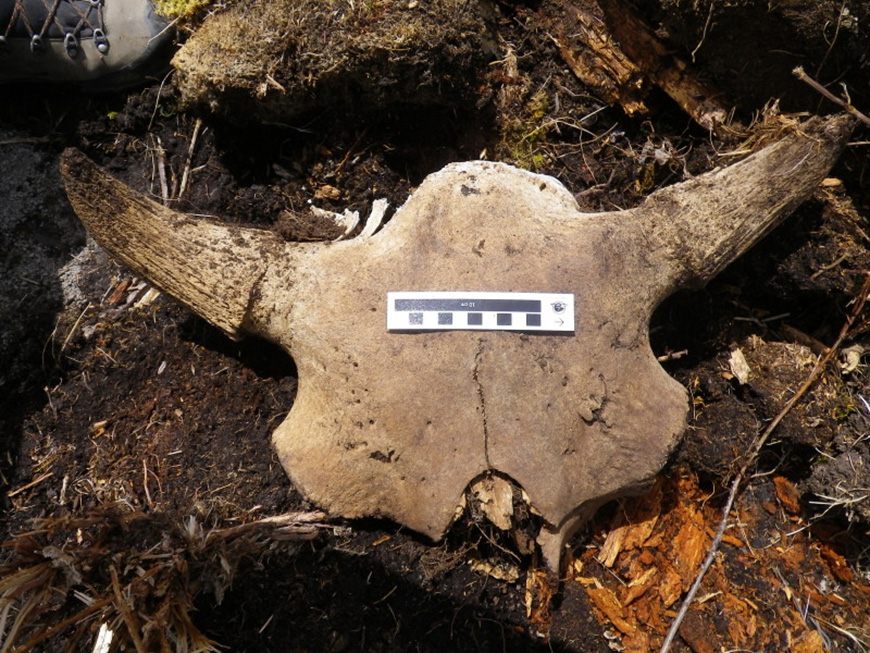
The bones also hold a key to understanding the lives of ancient bison in Banff. Bison roamed the plains, but the foothills and valleys of the mountains were also part of their historical range. Some may have migrated in and out of the mountains, while others may have spent most, if not all, of their lives within the rugged valleys of the Rockies. A clue that tells us about where they spent their time is locked in the collagen of their bones.

In addition to the radiocarbon dating, the lab also did another test, called isotope analysis, to shed light on the habitat and diet of the bison.
By comparing the carbon and nitrogen ratios stored in the bone collagen, we can estimate the ratio of mountain versus prairie grasses the bison ate over its lifetime. The analysis for our bone sample indicates that the bison spent most of its time eating (and living) in the mountains.
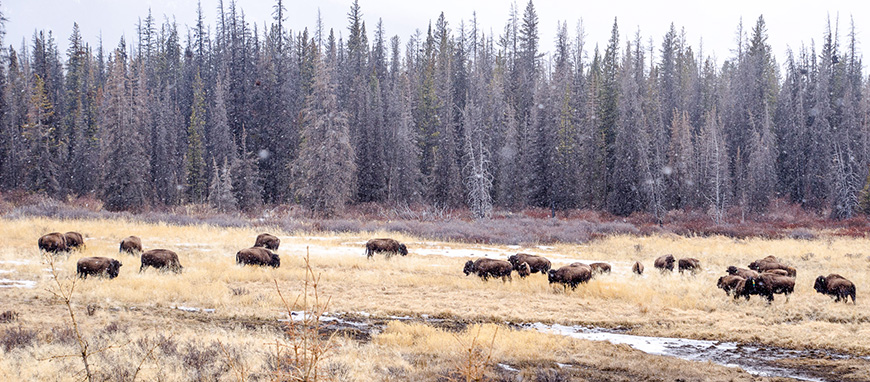
The results are consistent with modern samples and from those found further north in the park. This suggests some bison spent most, if not all, of their lives in the mountains. Our collection of bison bones is small, so we will continue to collect and analyse bones to deepen our understanding as they are unearthed.
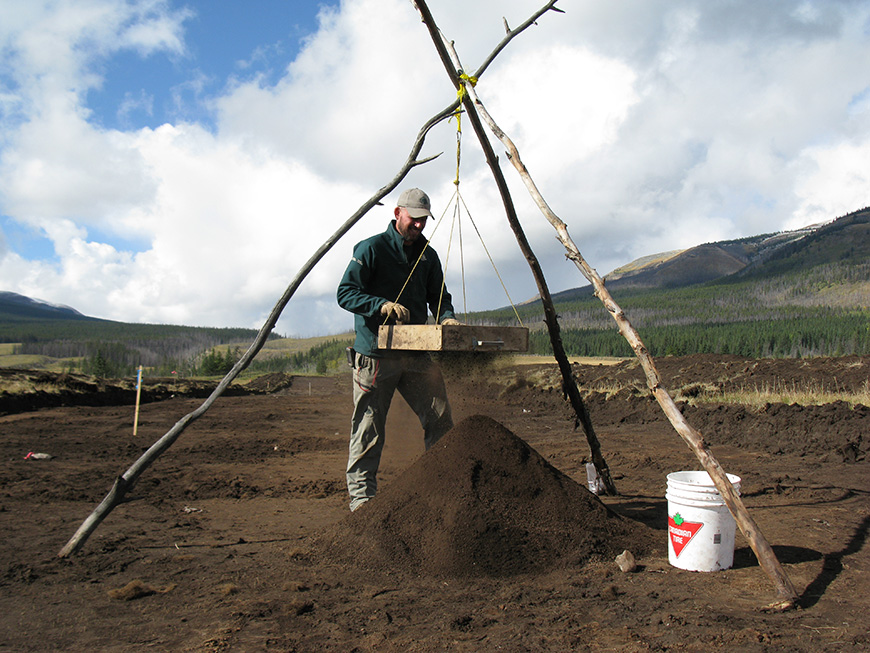
The discovery of bison bones increases the chance of finding culturally important sites since bison and people were so closely linked. These sites help us understand how bison, and the people who depended on them, may have used the landscape.
In the summer of 2018, our archaeology team discovered new artefacts during a survey following a prescribed fire in the Panther Valley. A bison bone fragment along with evidence of pre-contact Indigenous stone tools were found less than 200 metres from where our bison were held in a soft-release pasture for 1.5 years!
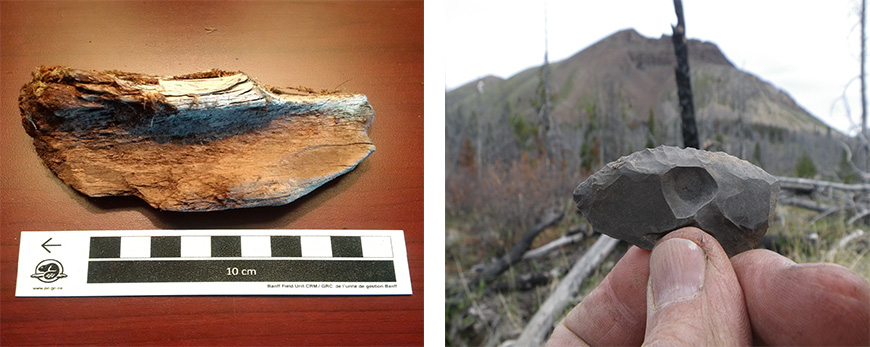
Parks Canada’s Terrestrial Archaeology team’s rigorous process helps us understand Banff National Park by discovering its past. With each new find, their work reveals the history of bison in Banff – building knowledge that will help guide decisions about their restoration.
Ancient bones only tell us part of the story. As the herd wallows, breaks trail and grazes the mountainsides, they may uncover new archaeological sites that suggest similar patterns of movements and behaviours hundreds or thousands of years ago. We can’t wait to see how the lives of Banff’s modern bison expose more clues about Indigenous and bison history in what is now Banff National Park.
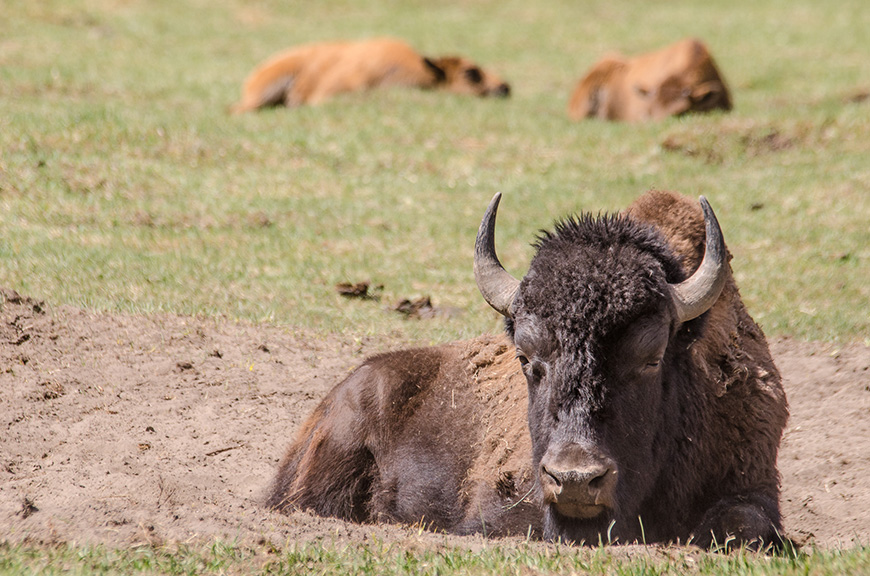
Thank you to Aaron Osicki, Jessica Hill, Meg Stanley and Gwyn Langemann for their research and assistance to make this post possible!
-
February 27, 2019: One Lonesome Buffalo
February 27, 2019: One Lonesome Buffalo
On a summer night at the end of July 2018, the bison herd crossed the threshold between captivity and freedom in the wilderness of Banff National Park. It was a historic moment for conservation. It was also the start of what has since become a solitary life for one of the herd’s bulls - bull #18 - in one of Banff’s remote valleys. This blog traces his journey since the herd was released 6 months ago.

Dawn slowly lifts across the valley. The herd is spending its first morning in the wild, high on a talus slope. #18 initially grazes alongside the herd but soon breaks from the group and continues northwards, leaving the rest of the herd to meander the ridges of the Snow Creek Valley in search of alpine plants.
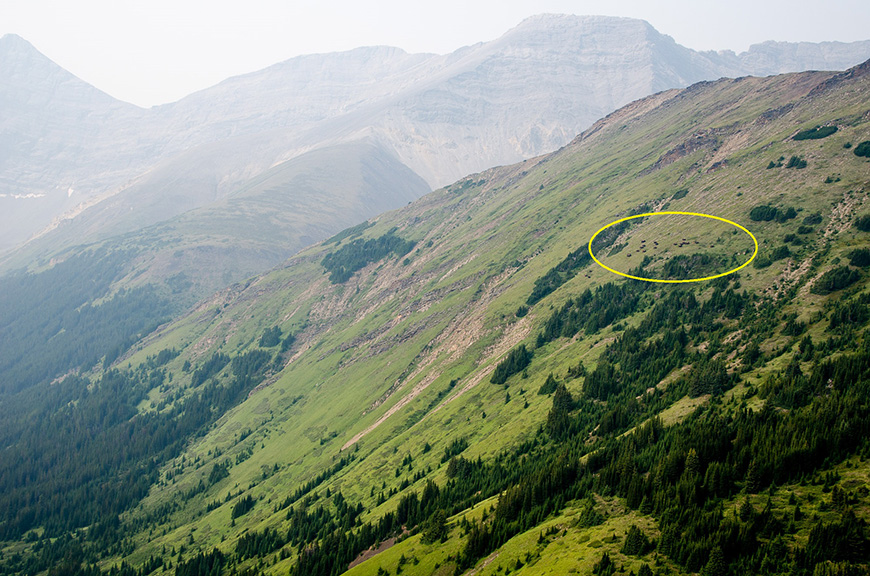
Edging across the slopes, #18 weaves his way between willow bushes and ambles down an old trail into the Red Deer Valley. For days, he explores meadows in the valley bottom. He picks through pockets of vegetation in an old burned forest. He eventually travels east, like the herd’s 2 other lone wandering bulls, but unlike them, he bumps into a stretch of fencing at the park boundary and returns westward. It would be the only interaction with a fence he has for the next 6 months.
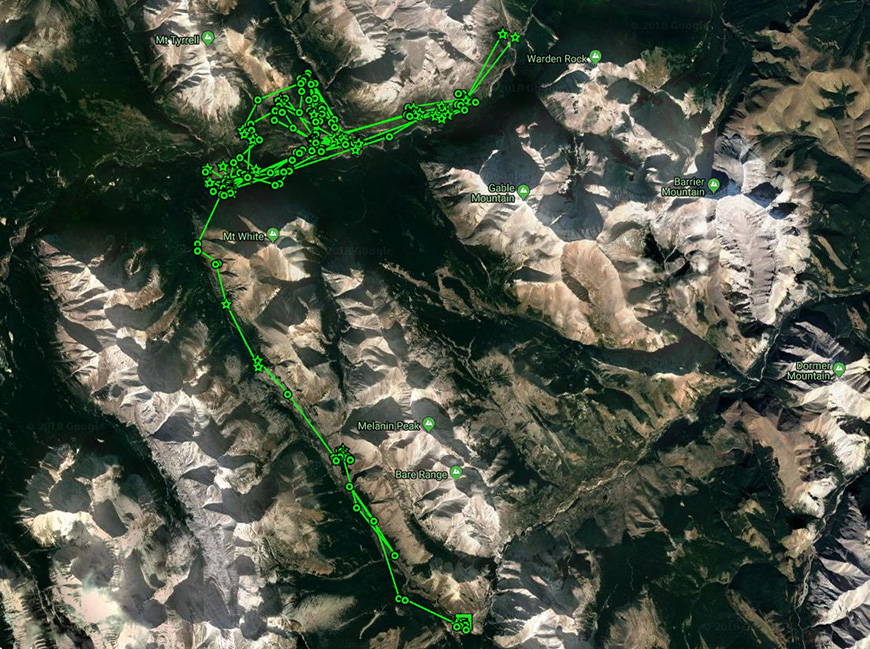
On his westerly trek back into the heart of the reintroduction zone, he turns north to follow Divide Creek. Along the way, he naps at an alpine lake and trudges through thick forest. He finally arrives in the Clearwater Valley in early September. This area is within the park but outside the reintroduction zone, so we deploy our staff to apply gentle pressure to redirect his movements. These efforts work to get the momentum started, and within a couple of days, he returns to his frequent haunt – the old burn in the Red Deer Valley.
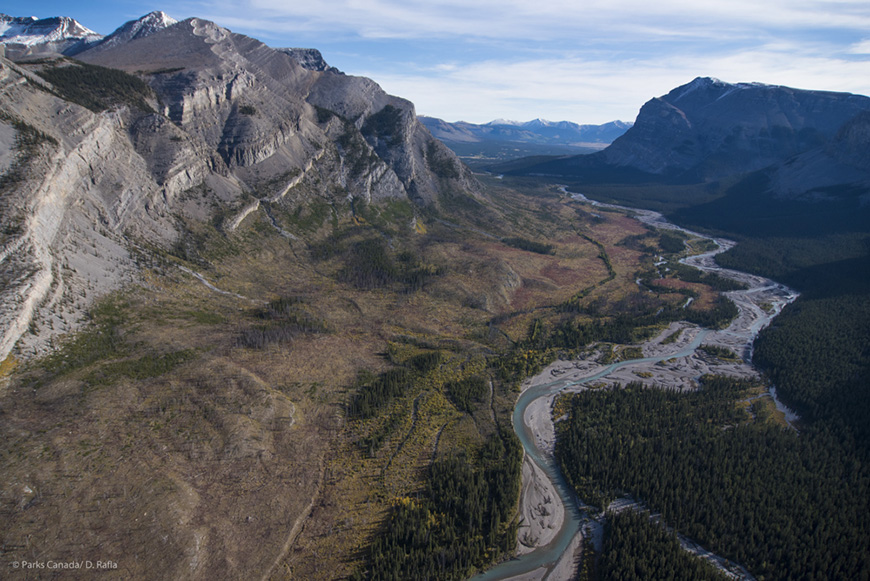
In late September, #18 makes a surprise reunion back with the main herd that is grazing in the Panther Valley. For a few days, they travel in lockstep, and then they part ways once more. #18 plods his way back to the Red Deer Valley, alone.
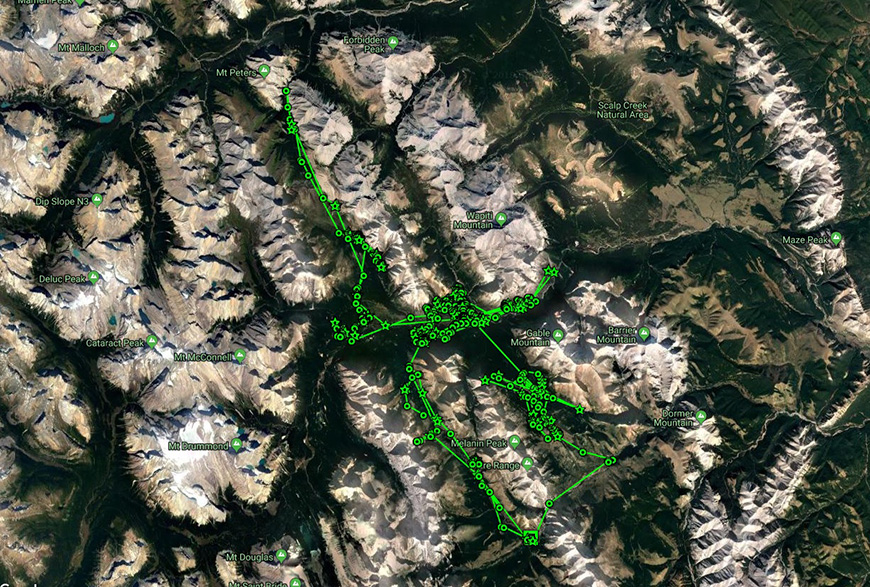
For months now, #18 has spent the majority of his time in the Red Deer Valley. According to our GPS data, he has crossed paths more often with the resident wolf pack than with other bison. Most recently, one of our staff snapped a photo of him at home on a narrow ridge in the alpine. Can you spot him in the photo below?
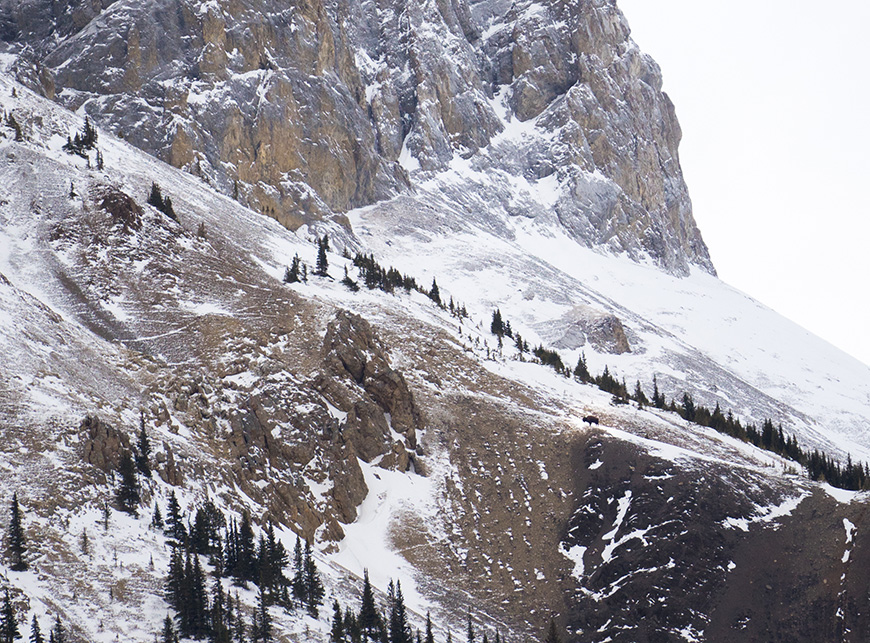
It’s normal for bulls to separate from the herd during the winter months. Bulls of breeding age tend to rejoin the herd for mating season in late July and August. What is interesting about #18 is his contrast with other bulls. Upon arrival to Banff, he was the oldest bull, but according to our field observations, he was one of the least dominant bulls during the soft-release phase. Following the full-release, the 2 most dominant bulls left the project area and were removed from the project, while the other bulls have generally stayed with the main herd.
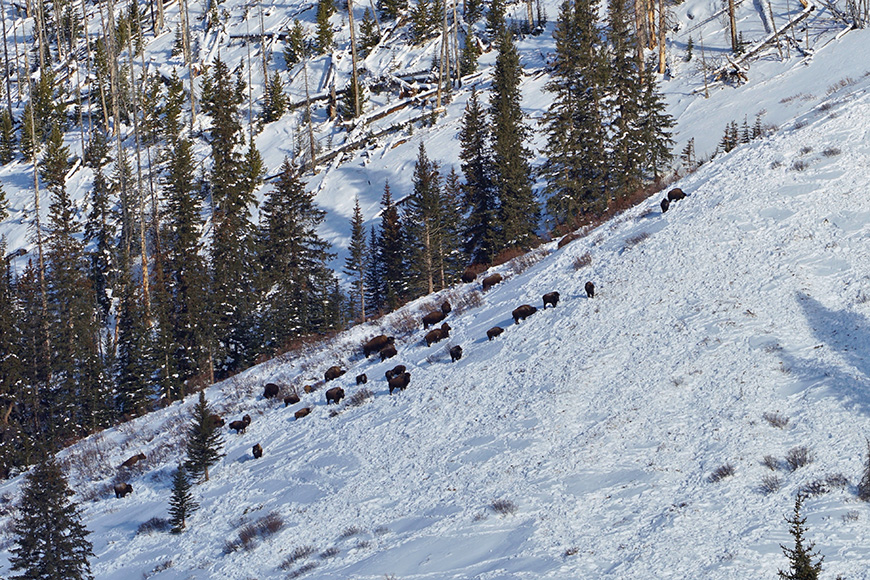
Each passing season teaches us more about Banff’s bison. Data from #18 and the rest of the animals, gathered through GPS collars, remote cameras and field observations, will help us understand how they establish home ranges and what influences their movements. We are looking forward to the spring/summer to learn more about #18’s behaviour. Will he return to the herd for mating season or will he continue his solo journey thru Banff’s remote valleys? Stay turned for updates on their movements in the coming months.
-
February 02, 2019: A Wild(er) Year
February 02, 2019: A Wild(er) Year
It’s been 2 years now since bison arrived in Banff’s backcountry as part of a 5-year pilot project. So far, their return has been an exciting, challenging and inspiring journey as the herd makes Banff a wilder place. Read more about year 1 of the project here and find some of our #herdhighlights from this year below:
For 18 months, our resource conservation officers cared for the herd in an enclosed pasture in the remote Panther Valley to help the herd adapt to life in the mountains.
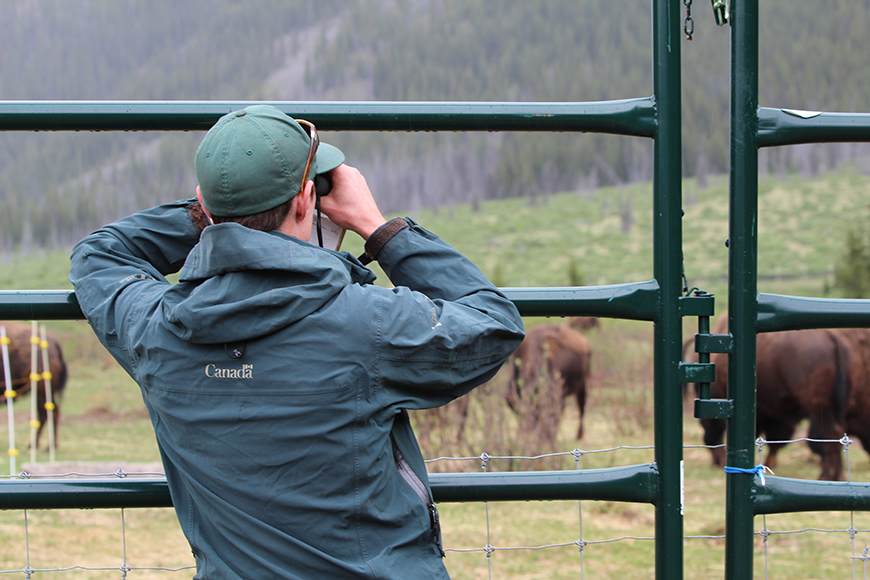
Even within the pasture, we observed the bison interacting with other species on a small scale, as they started to alter the landscape around them as a keystone species.
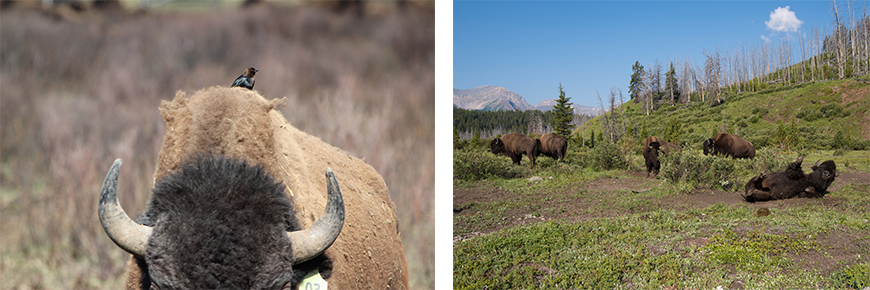
Before we released the herd, we used prescribed fire as part of on-going efforts to restore native grasslands in the reintroduction area. We successfully burned 315 hectares, in addition to 800 hectares burned in 2015, to create lush new habitat and forage for bighorn sheep, goats, grizzly bears, meadow-loving birds, elk ...and bison.
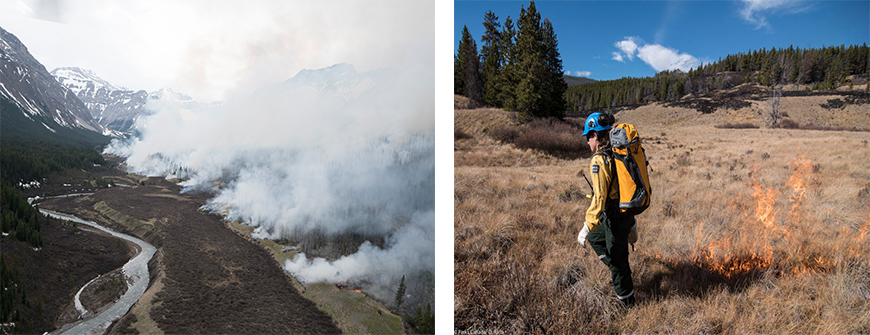
Starting in late spring, all 10 possible calves were born - the first “made in Banff” calves in over 140 years - bringing the total to 20 calves born over 2 calving seasons.
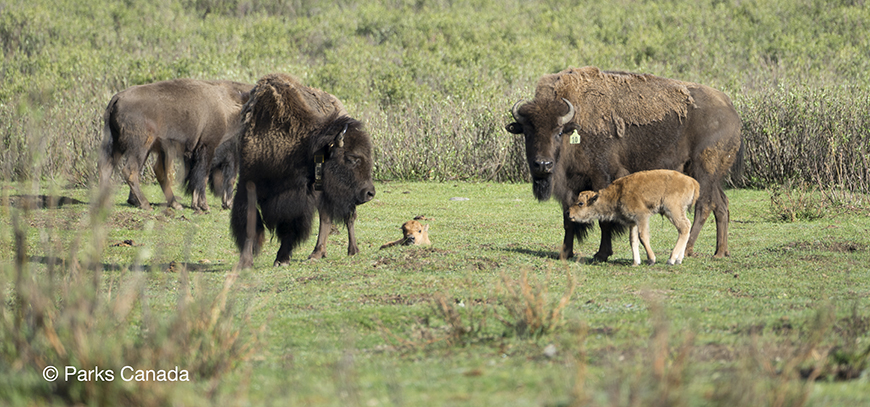
On July 29, 2018, we released 31 bison into the wild as a free-roaming herd. Since their release, the animals have been exploring unexpected terrain – like high ridges and steep drainages – as well as the grassy meadows and hillsides we expected them to frequent. The majority of the animals have remained within 15km of the release site but two bulls did wander outside of the reintroduction zone in the early days of the release.
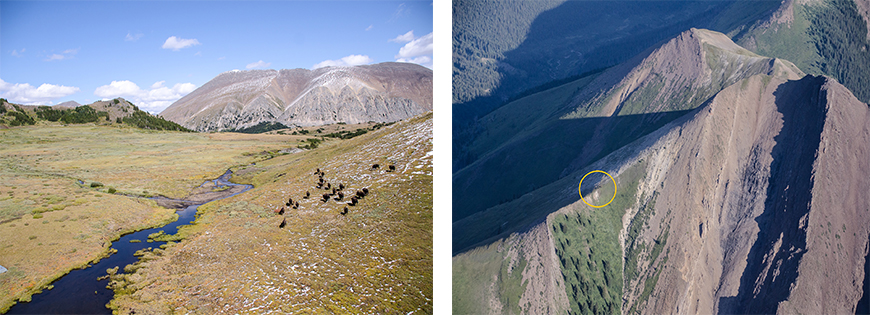
We continue to monitor and learn from the herd as they navigate their new home range. We have a variety of research projects underway to track their impacts on the ecosystem that use a number of noninvasive techniques, including scat collection and remote cameras.
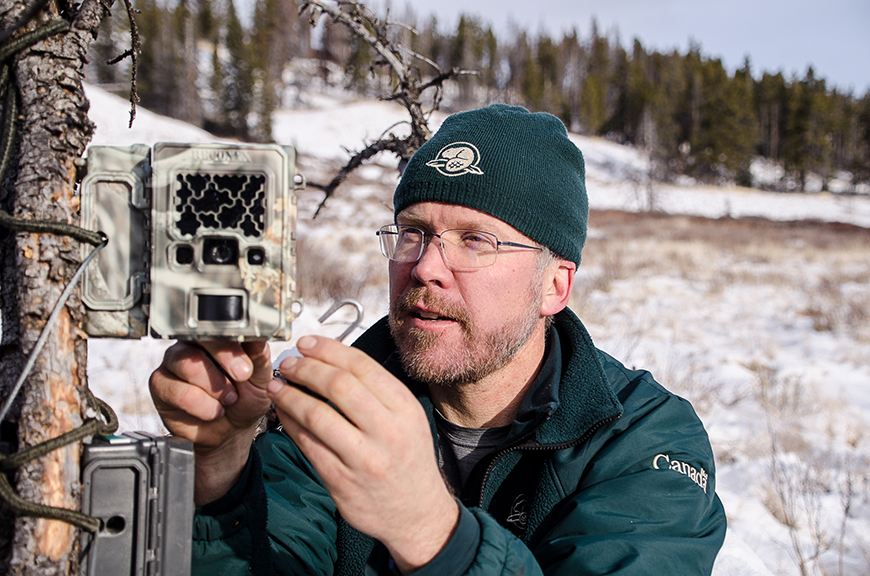
Sharing the bison reintroduction story with Canadians is a key part of the reintroduction project. This work includes collaborating with partners, engaging volunteers, digital storytelling, outreach programming and visitor experiences. For example, this year we launched 2 installments in our web-series, hosted an Indigenous blessing ceremony in the Panther Valley, engaged visitors at the Calgary and Toronto Zoos, and launched an exhibit at the Banff Park Museum. Thank you for your interest, enthusiasm and support as we work towards giving this imperilled species a second chance.
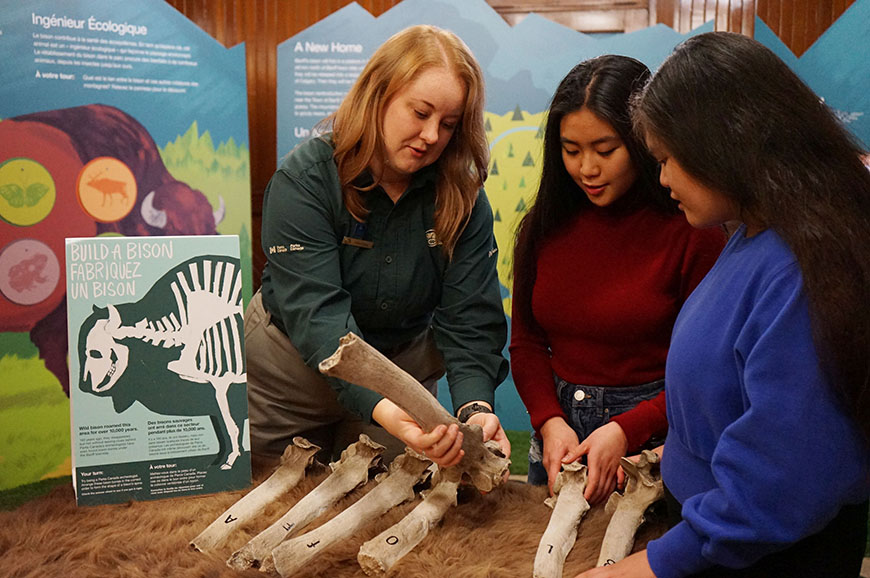
To learn more, follow the herd on this blog and on Facebook and Twitter.
-
January 15, 2019: In the Hoof-steps of the Herd
January 15, 2019: In the Hoof-steps of the Herd
Banff’s bison have been free-roaming for more than 5 months! All animals appear to be healthy and are adapting well to life in the wild. With the help of GPS collar data, remote cameras and field observations, we have been tracking the herd’s movements in one of Banff’s most remote backcountry areas.
.jpg?h=384&w=870&hash=1DBA1E3AD696B1D5691464D56D58858C)
The herd currently consists of 34 animals – an increase of over 50% from the initial starter herd of 16 bison (10 cows and 6 bulls) from Elk Island National Park. All 10 cows gave birth to calves in 2017 and 2018; adding 20 “Born-in-Banff” animals to the herd.
The bison have been moving mostly as a group in the northeast section of the reintroduction zone. In the initial weeks post-release, the herd spent their time in habitat at higher elevations – along talus slopes and shores of alpine lakes.
.jpg)
As fall settled in, the herd transitioned to grazing in lower elevation meadows, grassy slopes and recently burned forest in the upper Panther and Red Deer valleys of Banff National Park.
.jpg)
So far, Banff’s bison appear to be bonding well to the landscape and learning where to find good grazing habitat. The map above shows the locations of the 34 animals since their release (July 29 – Dec 11, 2018). Each colour represents a different animal and the distance between each point represents 2 hours of movement. The teal coloured line to the North represents a bull that spends much of his time alone in the Red Deer Valley; while the navy coloured line to the East represents a female bison that went on a brief adventure beyond the park boundary in October.
.jpg)
We continue to learn from the herd through on-going research and monitoring, as they reclaim their role in the ecosystem as a keystone species. Part of this research includes their interactions with predators. To date, bison have been observed interacting with wolves and grizzly bears but, to our knowledge, no predation attempts have occurred.
.jpg)
It is incredible to see these animals thriving in the wild after an absence of 140 years – like in this image from a remote camera in the Panther Valley in November 2018. With each passing day, they continue to prove that bison really do belong in Banff National Park.
-
October 25, 2018: Where the Buffalo Roam – a wandering life for Parks Canada’s bison stewards
October 25, 2018: Where the Buffalo Roam – a wandering life for Parks Canada’s bison stewards
As we highlighted in past blog posts, our Parks Canada team on the bison project has a very special job: monitoring the Banff bison herd as they return to the landscape. We call these staff bison stewards.
The life of these bison stewards has changed in a big way since we released the animals in July. Now, instead of being based at a single patrol cabin where the bison were held in a pasture for 1.5 years, our team has had to follow the herd to learn how bison travel the landscape. Where they go, we go.

For 9 day shifts, bison stewards travel into the backcountry on foot, ski or horseback on a journey with no set destination to allow them to follow unpredictable bison movements. While in the backcountry, bison stewards monitor the herd to collect information about animal health, behaviour and their use of the landscape.

In the map above, you can see the travel route of a bison steward shift in September 2018. They travelled 110 kilometers, slept in two backcountry patrol cabins, worked through sunny, cloudy, windy and snowy weather, backtracked a few times, and adjusted their plans daily based on the locations of the herd.
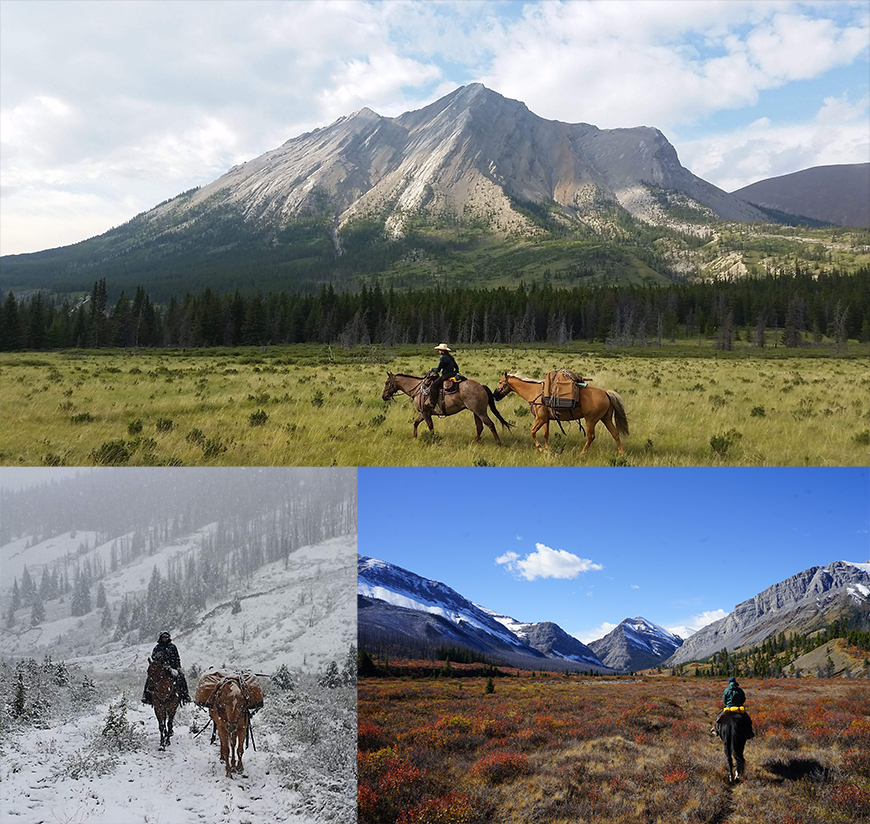
Using telemetry, they listen to signals sent by the bison’s radio-collars. Following these signals, they can track the herd to observe the animals in their new habitat.

Pairing field observations with GPS data we get from the collars, we are starting to learn about the Banff bison herd. Here are some of the things we have seen so far:
- All 10 calves, out of a possible 10, have been born in Banff’s backcountry bringing the herd to 34 bison.
- The animals are traveling through unexpected terrain. They have been spending time on high ridges, steep drainages and at alpine lakes.
- The herd has been shifting in and out of smaller groups of animals that are exploring key grazing areas.
- The bison seem to be developing an affinity for their new range, just like we hoped they would:
- Some have returned to the soft-release pasture in the Panther Valley at various points over the past few months.
- A cow and her young took a 50 km return two-day trip in early October; including areas out of Banff National Park and back again to rejoin the herd.

In addition to keeping an eye on the herd, bison stewards have long days that range from setting up remote cameras, taking down the soft-release pasture fences, clearing trails, to gently shepherding the bison. Each day is different when you travel where buffalo roam. We are so excited to discover new things about these wild wanderers in the coming months as winter arrives in the backcountry.
-
September 27, 2018: Friends in High Places
September 27, 2018: Friends in High Places
If you walk a ridge in Banff’s eastern slopes you are likely to find traces that animals left behind. Sheep tracks, goat droppings and elk antler sheds. Now we have one more thing to add to the list: bison dung.
While observing the herd, our staff came across bison “patties” left high on a mountainside. This is great news for those alpine plants that will benefit from the nutrient-rich patties next spring.

The main herd has spent most of their time in the Snow Creek Valley following their release into the wild. They have been grazing, bedding and raising their calves at high alpine lakes and on mountain slopes in one of the most spectacular areas in Banff’s backcountry.

They are now familiar with the Snow Creek Valley and know they can return there in spring and summer to forage. In these initial months following their release, we want to help them discover key areas in their new range so they will be aware of seasonal grazing opportunities throughout the reintroduction zone.

One place we wanted to show the herd is the Lower Panther Valley - a landscape of rolling meadows that is snow-free most of the year and offers some of the best fall/winter grazing in the area.
Remember the stockmanship techniques we told you about in spring 2018? We used those skills with a combination of staff on foot, horseback and helicopter to gently herd the animals south towards the Panther Valley. On September 4th, we successfully encouraged the herd to calmly walk about 15 km southwards; eventually ending up right back where they started – in the soft-release pasture. It was an incredible sight to see 27 bison walking single file along ridges, edging along talus slopes and winding through willows in the valley bottom.

The yellow lines show the herd’s movements From September 4, 2018 to September 7, 2018Overnight, we opened the soft-release pasture fences to the east to encourage the herd to move eastward into the Lower Panther Valley. And it worked! The herd moved into those open meadows and have been grazing there for around three weeks. Look how beautiful this place is!

As the snow starts to fly in the Panther Valley, we will continue to keep our eye on the herd as they begin their first winter as free-roaming bison. We are also monitoring a bull that explored a nearby valley within Banff National Park in early September.

The yellow lines show the bull’s movements from September 4, 2018 to September 7, 2018On the map above, you can see his movements north towards the Clearwater Valley, but thanks to steep terrain and with a little encouragement from our bison wranglers, he was turned around and headed southward. Just as they are learning their new landscape, we are learning from them.
-
August 28, 2018: The Good, the Bad and the Buffalo - reintroducing bison isn’t always easy!
August 28, 2018: The Good, the Bad and the Buffalo - reintroducing bison isn’t always easy!
The Banff Bison Project is an unprecedented opportunity for conservation in the mountain parks, however, we have recently experienced some challenges. Watching the main herd roam through high alpine basins with their newborn young filled us with hope and optimism. However, we have also had to make tough decisions to remove two bulls that wandered far beyond the reintroduction zone.

Almost a month after the release of 31 bison into Banff’s backcountry, the majority of the herd has remained within 15 kilometers of the release site. However, two bulls ventured eastward well beyond the park boundary and were within a day’s walk from private lands. Our reintroduction plan and commitments to provincial stakeholders, promised that we would keep bison out of these areas.

Yellow shows movements of all members of main herd while blue shows movement of the two bulls since the date of their release on July 29.We considered capture and relocation for the first bull, but concluded that it was not feasible due to several factors including:
- the speed at which the bison was moving east,
- the main herd was also travelling northeast into challenging terrain where hazing efforts would be less effective – we needed to focus resources on managing the main herd,
- wildfires limited the availability of helicopters able to capture and transport an animal as big as a bison, while thick smoke reduced visibility, and
- we had to consider potential risks to the bison team in attempting to immobilize and move bison under these constraints.
In the end, we made the tough decision to euthanize this first bull.
Fortunately, several days later, we were able to successfully capture and relocate the second bull, to a temporary home in Waterton Lakes National Park. This was a very challenging operation that involved a contracted capture team netting the bison from a helicopter. We then immobilized it, and rolled it into a custom built bison-bag that allowed us to sling the immobilized bison under a large helicopter without compromising its airway, just long enough to lift it into a nearby horse trailer for transport

The immobilized bison bull being slung by helicopter as part of the capture and relocation operation. This bull was later transported by truck to Waterton Lakes National Park.Decisions to relocate or destroy an animal are difficult for our team and are made only after we have considered all other options. These two bulls were determined to travel eastward past any obstacles in their way, and they taught us a lot. We have modified our herding techniques and have expanded some strategic drift fencing.

The herd is currently doing well and staying high on the mountainsides to forage on fresh vegetation and stay out of reach of biting flies. Since we released the herd, at least 4 more calves have been born in the wild! The herd now consists of 10 adult females, 4 adult bulls, 10 yearlings, and now 9 calves, totaling 33 animals. These bison appear to be settling into their new home and all animals are within the core reintroduction area.

We are also pleased that the Province of Alberta recently announced that bison will now be protected as wildlife, within a “Special Bison Area” on provincial lands, along the eastern side of the reintroduction zone. This will give our bison a little more breathing room if they leave Banff National Park.
Reintroducing North America’s largest land mammal was never going to be a simple task, and there may be more challenging days ahead. Yet, we are optimistic that bison have a bright future in Banff National Park. Thank you to our partners, Indigenous and local communities and the public for your support.
-
August 11, 2018: Bison are exploring Banff in new ways
August 11, 2018: Bison are exploring Banff in new ways
It’s been a big week for Banff’s bison. On July 29, we opened the fence of the soft-release pasture and released the herd to roam a 1200 sq km reintroduction area in Banff’s eastern slopes.
We spent 1.5 years helping these animals learn to adapt to their new home. Now the tables have turned, and we have started to learn from them. They are already teaching us new things about what it means to be a mountain bison.

On release day, we opened the gate around noon and waited for the bison to find the opening. And we waited. And finally, around midnight, we captured the herd on camera crossing the fence-line and moving through the release corridor we built for them.

The next morning, we awoke to find the soft-release pasture empty: bison had finally found their freedom. We sent our team into the field to monitor the herd using telemetry to trace their radio collar signals. When we picked up their signals… we were surprised with what we found.

Instead of following the valley bottom like we expected, the herd travelled and stayed high on the mountainsides, grazing and bedding in the uppermost fingers of vegetation that edge into the rocky slopes. We watched as they dipped down to the creek for a drink and then returned up the slope to bed down. Two pregnant cows then climbed even higher to an alpine lake where they gave birth to the first wild calves born to the free-roaming herd – bringing the herd to 33 animals. Two other cows with newborns summited a nearby ridge overlooking the soft-release pasture.

This is a new experience for these bison, as they have never lived without fences. They are learning their new boundaries, getting their first views of the landscape before them, and testing their mountain legs. The vast majority of the herd seem content within 6 km of the initial release site, while a few bulls have ventured into a nearby valley and one bison bull has left the core reintroduction area and is currently on Province of Alberta lands just east of the national park. We continue to follow his movements closely, and may try to capture him if this walkabout takes him further east.

We have been carefully tracking the herd and are ready to take action if they venture too far. We will continue to monitor them while working closely with the Province of Alberta and nearby stakeholders as these wild bison settle into their expanded range.

Even within the first couple of days in the wild, Banff’s bison are showing us that they are made for this place and ready for the challenges it brings. You can follow the herd as they teach us new things about bison on the Parks Canada YouTube channel and on our Banff National Park Twitter and Facebook channels.
-
August 2, 2018: Free to Roam - bison are released into Banff’s backcountry
August 2, 2018: Free to Roam - bison are released into Banff’s backcountry
It’s official. Bison have returned to the backcountry of Banff National Park. After an absence of over a century, bison will once again roam the valleys of Canada’s first national park. They will carve new paths and seek new adventures. They will cross rivers and meet wolves and bears. And most importantly, they will call Banff their home.

Plains bison once filled the air of the Great Plains with grunts and the thunder of hoof steps. Numbering as many as 30 million, their herds sometimes stretched far into the distant horizon. For 10,000 years, small numbers of these animals even wandered what is now Banff National Park. But unfortunately, within a single human lifetime, bison were nearly driven to extinction.
Their story didn’t end there. For over a century, Parks Canada has been leading the charge to restore wild bison in Canada. In 2017, the Agency added a new chapter to this conservation story through the reintroduction of bison from Elk Island National Park to Banff National Park.

For the past year and a half, Parks Canada has cared for the animals as they adapted to their new home in Panther Valley in a remote area of Banff National Park. They were held in a soft-release pasture to anchor them to the location and help prepare them for their new life in the mountains.
Now, the bison are ready for the next phase of the journey: free-roaming. We released the herd from the soft-release pasture and bison are now free to roam a 1200 sq km reintroduction zone in Banff’s eastern slopes. They will start to fulfill their role in the ecosystem as a “keystone species” by creating a vibrant mosaic of habitats that benefits bugs to birds to bears, and hundreds of other species.

As bison explore their new home, we will use GPS collars to track their movements across the landscape and their interactions with other native species.Over time, we hope to learn how bison integrate into the ecosystem and understand their impact on the surrounding landscape. At the end of the pilot project in 2022, we will evaluate the success of the project and determine the future of bison restoration in Banff.

You can follow the herd as the project evolves on this blog, on the Parks Canada YouTube channel and on our Banff National Park Twitter and Facebook channels. We can’t wait to share this exciting new chapter in the reintroduction with you.

-
July 23, 2018: First Wild Steps ... baby bison have arrived!
July 23, 2018: First Wild Steps ... baby bison have arrived!
The first calves of the season have arrived in the bison pasture in the Panther Valley! They have the special title of being the first “made in Banff” bison babies.

Cow #6, #10 and #11 are the proud mommas of these new little critters. Our staff have been keeping a close eye on them, and many of the animals in the herd (especially the curious yearlings) have already sniffed the new calf to say hi.
Bison calves are born with bright reddish fur – giving them the nickname of “little reds”. After a few months, they start to look more like the chocolate brown of their parents. We expect to see more little reds running around the pasture in the coming months as the rest of cows give birth, and if all goes well, we could see up to 5 or 6 more join the herd.

This is the herd’s second calving season in the soft-release pasture, and it’s one of the main ways we’re helping them bond to their new home range. Bison tend to return to the same areas to calve each spring.
By holding them for two calving seasons in the heart of the reintroduction zone, we hope that the herd will adopt this area as their annual calving ground. If they do, new generations of little reds will scamper around the Panther Valley each spring for years to come.
-
June 15, 2018: Burning for Bison
June 15, 2018: Burning for Bison
Bison need fire. The health of Banff’s ecosystems depend on both of them.
On May 15th and 16th, we completed a prescribed fire in the bison reintroduction area to help restore native grasslands. We burned approximately 315 hectares to create lush new habitat and forage for bighorn sheep, goats, grizzly bears, meadow-loving birds, elk and…our future free-roaming bison herd.

The relationship between fire, bison, and people shaped this area for thousands of years. Grazers, like bison, are attracted to the fresh grass that emerges after a fire. As they focus on the nutrient-rich new growth, older vegetation gets a break from grazing before it gets burned and grazed again. Over time, this creates a mosaic landscape that supports a diversity of plants and wildlife.

Planning a prescribed fire is all about defining the right conditions. A window of opportunity opened this spring when the days were warm, snow was clearing, but the grass hadn’t started to green up. This meant that a targeted area could be burned with a low risk that the fire would spread.
Over two days, our fire management team burned an area near the bison pasture. Working methodically, they ignited vegetation from both helicopters and drip torches on the ground. They burned meadows on the edges of forest that still had snow on the ground in places – perfect for holding the fire. Meanwhile, since bison are so well-adapted to fire, the herd hardly seemed to notice all the excitement. They bedded down to enjoy a lazy day in the sun.

By the end of the last day, the fire management team had successfully lit all targeted areas. With 15 mm of rain on the way that evening to douse the flames, the timing couldn’t have been better. Over the coming weeks, the crew carefully monitored the burned area and extinguished any remaining fire. They also set up a remote camera to continue to observe the area. The photo below was taken by the camera and shows the recently burned area (in orange) and an older burn from 1999.

As fresh green shoots poke out from the charred meadows, a variety of creatures will be drawn to this area – from grizzly bears to songbirds. The lush vegetation should also attract bison once the herd is released this summer and help anchor them to this area of Banff National Park.

-
May 20, 2018: On the Road Again
May 20, 2018: On the Road Again
Our conservation team just learned a few new tricks.
When the herd is free-roaming this summer, we will gently push the animals on horseback to help them explore key grazing areas of their new home range. This April, our core bison team travelled to Montana to get more practice herding bison on horseback before the paddock gates open this summer.

We will be using a technique called “natural stockmanship”, a low-stress approach to interacting with herd animals, like bison. We adopted this philosophy as a core project tool to guide our interactions with the Banff bison herd, and we have been practicing since before the bison even arrived in early 2017.
The problem is that it isn’t easy to get the experience we need to work with free-roaming bison in the backcountry while the herd is still in the paddock. So we had to hit the road.
Our core staff had an opportunity to spend a few days working with experienced cowboys on a large ranch that uses horses and natural stockmanship to help manage over 1000 bison.

After a winter on skis, our bison team got back in the saddle for some long days on the range. Volunteering as ranch-hands, they helped the resident cowboys move hundreds of bison between pastures. They crossed streams and traversed kilometers of sage brush all under a wide Montanan sky.

The landscape down there is definitely different than Banff’s backcountry, but having a chance to practice some key herding skills gave our team a better sense of what managing free-roaming bison in Banff might be like. It’s going to be a wild ride.
-
May 6, 2018: Bison are Already Changing Banff
May 6, 2018: Bison are Already Changing Banff
Bison have been back in Banff for just over a year, but they are already shaping the landscape. Bison are what are called keystone species, or “ecological engineers”. That means that through their natural behaviours, they alter the ecosystem around them and benefit a huge number of other creatures.

Bison travel in large groups. They rub against trees. They nibble on fresh grasses. They leave large dung plops in their wake. They roll on the ground, making craters in the soil called wallows. All of these actions create a rich mosaic of different habitats – helping increase biodiversity.
Wild bison are an important part of Banff’s ecosystem. By reintroducing bison to Banff after they were absent for nearly 150 years we expect to a range of benefits, such as:
- More forest openings for meadow-loving birds and other small mammals.
- Well-fertilized grass for other grazers like elk and deer.
- More seasonal wetland habitat for amphibians due to bison wallows filling with water.
- A new food source for a community of creatures including bears, wolves, ravens, and coyotes.
We are already starting to see these changes happening on a small scale. Bison have formed large wallows in the paddock. They’ve rubbed against trees – leaving pieces of fur behind that have been picked up by birds for their nests. They’ve started to carve out trails in the forest. Their dung is providing habitat for insects that then become food for birds and small mammals.

Photo 1) a bison wallow in the bison paddock Photo 2) bison fur left on rubbing treesWhen the herd is released this summer, we hope to see these changes continue over the wider landscape. We will measure impacts that bison have on the ecosystem over the course of the reintroduction pilot project. Research includes studying songbird populations, vegetation, amphibians, and, as we highlighted in our November 2016 blog, dung beetles.
-
April 29, 2018: Life at Windy
April 29, 2018: Life at Windy
Over the past 15 months, our conservation team has had a special job in Banff’s backcountry: watching over a herd of bison.
The bison pasture is located in one of the most remote parts of the park. It takes 2 days to get there on foot, ski or horseback from any direction. It’s a wild place where you are more likely to see a grizzly bear than another human being.

For weeklong shifts, bison stewards are posted at the Windy Patrol cabin – a stone’s throw from the bison paddock. Their job is to feed the animals, monitor the herd’s health and track the behaviour of each bison.

Each morning, staff haul bales of hay into the paddock and spread it for the herd’s breakfast. While the herd eats, they take a perch overlooking the pasture and complete health observations.

Staff also need to take care of some smelly business: cleaning up bison dung. Bison poop a TON…actually. Each adult bison produces about 35 lbs lbs of dung per day, adding up to half a metric ton produced daily by the herd of 26 bison.
It’s important to keep manure levels in check to reduce the chances of the animals contracting parasites. It means that on average, staff spend around 3-4 hours each day shovelling poop – sometimes so frozen that they need to use an axe to chop the patties out of the snow. This stinky work is paying off: according to recent tests, the herd’s parasite loads are very low.

Beyond bison care, staff have daily chores including chopping wood, tracking wildlife observations, checking remote cameras and keeping the horses happy. It’s a quiet life out in the backcountry, but it’s about to get a little more interesting once the pasture gates are opened and the bison are free-roaming this summer.
-
April 8, 2018: Bison Bling
April 8, 2018: Bison Bling
On a chilly week in early March, our team of veterinarians and conservation specialists flew to the bison paddock in the remote Panther Valley of Banff National Park to start a big task: radio collaring the adult female bison and giving ear tag transmitters to their calves.
These collars and ear tags work by sending out signals that will help us trace their location. They will be important tools for the reintroduction project once the animals are free-roaming in summer 2018.
The data we collect will help us track the animals as they explore a landscape that has not seen wild bison in over 140 years. Here are some things we will be looking at:
- Bison movements,
- Interactions between bison and their predators, and
- Survival rates.
Here is how collaring was done:
Handling animals can be stressful for wildlife. To reduce impacts on the animals, the bison were chemically immobilized, one-by-one, with a tranquilizer.

Once the animal went to sleep, we gently blind folded them to help keep them calm throughout the procedure. Then, our team of veterinarians and conservation specialists performed pregnancy checks on the females, collected various samples (like hair and blood), and attached ear tags to the calves.
Finally, the animals were given a radio collar (adults) or ear-tag transmitter (calves) that allows us to locate them. The calves didn’t get collars this time because they are still growing and the collars would get too tight.

When all the steps were completed, the bison were given a reversal drug and within minutes, they were awake, standing and back with the rest of the herd.

Overall, the week went well and most of the animals have both collars and ear tags now. We will collar the males later in the early summer, so that by the time they are free-roaming, the rest of the herd will all have matching collars.
We can’t wait to see what we will learn from these animals once the data starts rolling in this summer!
-
March 20, 2018: Bison babies are coming!
March 20, 2018: Bison babies are coming!
We have some exciting news from the bison paddock in Banff National Park’s backcountry: at least 9 of the 10 cows are expecting calves this year!

As part of a recent field project to attach radio collars and ear tag transmitters to most of the animals in the herd (more details coming in our next blog post), our Parks Canada veterinarians also performed pregnancy checks on the females.
According to the vets, the cows could start giving birth as early as April and continue through the summer. Last year’s first calf was born on Earth Day (April 22), and we can’t wait to welcome new members to the herd.
It’s important to remember though, that these are wild bison and it is normal that some cows may not bring their calves to full term. But if all the calves are born successfully, it could bring the herd’s number to 35 animals – a long way from the initial 16 bison that arrived in Banff last February.
-
February 6, 2018: Year of the Bison
February 6, 2018: Year of the Bison
It’s been a big year for bison in Banff. This week marks the one year anniversary of bison making a comeback in Canada’s first national park. Let’s look back on some of the shiver-worthy milestones from this landmark project.
Prayers were spoken and songs were sung at Elk Island National Park – the original home of Banff’s bison. Treaty 6 and 7 Nations and the Métis Nation of Alberta helped give bison a proper blessing before the herd began their journey to the mountains.

The bison were loaded into special containers, and we drove through the night as a convoy to the Ya Ha Tinda Ranch, on edge of Banff National Park.

Early the next morning, a helicopter lifted each container and flew them over the horizon to their new home in Banff National Park.

Staff in Banff’s remote Panther Valley waited with anticipation as they opened to door to each container. One by one, the animals bolted from the containers and started to explore their new home.

On Earth Day, the first wild bison calf was born in Banff’s backcountry. This ball of cuteness was followed by 9 other healthy calves – bringing the total number of bison in the herd to 26.

Bison coming from Elk Island had a lot to learn about living in the mountains. Having grown up in a prairie landscape, they had never seen a river or a mountainside. While in their summer pasture, the herd crossed a river for their first time in their lives!

The herd is growing up so fast. They are still doing well in their pasture in Banff’s Panther Valley. We have a staff member watching over them 24/7 and we will continue to care for them until their full-release in July.

In July, we are planning on opening their pasture gates and moving into the next phase of the project: free-roaming. The herd will roam an area the size of Calgary (approx. 1200 sq km) until 2022. We will continue to monitor the herd as they return to the landscape as wild bison.

Since the herd is remote, sharing the bison story with Canadians has been a big part of this project. We hosted a series of community events, interpretive programs and virtual experiences (such as this blog!) to help give Canadians and visitors from around the world a chance to connect with this historic reintroduction. Stay tuned for on-going ways to connect with the herd!

-
December 22, 2017: Banff, bison and ... horses
December 22, 2017: Banff, bison and ... horses
Imagine the old days of Banff National Park. Wardens travelled the rugged backcountry – crossing mountain passes and fording glacial rivers…all on the back of a horse.
Much has changed in a hundred years, but at least one thing holds true: horses are still the best way for Parks Canada staff to travel in the mountains.

Horses are also helping bring bison back to Banff. We have a Parks Canada bison steward watching over the herd 24 hours a day on week-long shifts in the backcountry. The bison are in one of the most remote parts of Banff, so we use horses as our main mode of transportation in and out of the field.
To get there, we pack up the horses and ride for two full days into the heart of the bison reintroduction zone. Along the way, we get a glimpse of Banff at its wildest: wolves howling, wolverine tracks and sheep looking down from ridges above.

The Parks Canada work horses have taken a break for the winter season, but come next spring, we look forward to hitting the trail with our trusted companions again.
Happy Trails!

Thanks to Dillon Watt, Resource Conservation Officer and Bison Project Team member, for his best horse stories and help crafting this post.
-
November 22, 2017: What can bison poop tell us about Banff’s ecosystems?
November 22, 2017: What can bison poop tell us about Banff’s ecosystems?
Guest Blog: Nicholas McKay
With bison back in Banff, Parks Canada has a chance to track their impact on the landscape before and after they are free-roaming in 2018. Tracking how they shape the environment sometimes means that we need to look at the smaller parts of the ecosystem. As a summer student, I studied one of the smallest parts of the ecosystem – one that loves poop. I am, of course, talking about dung beetles!

Dung beetles play a key role in the environment. They help decompose dung. This process cycles nutrients back into soil which helps plants grow, like the fertilizer in your garden. Dung beetles are also an important food source for many birds and rodents within the ecosystem.
This summer I surveyed for beetles using what we call a “pitfall” trap. These traps are made of a plastic pail placed in the ground with something tasty used for bait. What bait do you think I used to trap dung beetles? You guessed it … bison dung. And it worked! After a month of trapping I identified six different species of dung beetles.
Once the bison are released from the soft-release pasture, we hope to survey the same areas again. This will tell us if these insect populations increase after bison are back on the landscape.
Nicholas McKay worked on the bison reintroduction project this summer as a student researcher. Along the way, he became an aspiring dung beetle expert.

-
September 6, 2017: Banff Elementary School Students Welcome Bison
September 6, 2017: Banff Elementary School Students Welcome Bison

Soon after bison landed in Banff in early 2017, we gathered grade four students at Banff Elementary School for a special assignment: become local ambassadors for bison.
We asked the students why they thought bringing back bison was important. We heard:
- “Because the land needs them”
- “Because they were here for a long time”
- “Because they are important for spirituality”
Then the students rolled up their sleeves, mixed up some paint and coloured their own little bison with help from the Honourable Catherine McKenna, Minister of Environment and Climate Change.
This cool art project was a story in collaboration: students at the neighbouring Canmore Collegiate High School used a laser-cutter to make adorable bison wood cut-outs.
Once the paint dried, we picked 16 bison to represent the original herd from Elk Island National Park that started the Banff reintroduction. The rest of the “herd” will decorate the fence of the new Banff Elementary School.
This summer, we brought those 16 finished shapes to the soft-release pasture in the Panther Valley, home of the Banff bison herd, to decorate the fence! Don’t they look beautiful?

Thanks to all of the new “Bison Ambassadors” at Banff Elementary School for helping our Banff Bison feel welcomed.
-
August 30, 2017: Summer Vacation for Bison
August 30, 2017: Summer Vacation for Bison
Guest Blog: Karsten Heuer

Our bison have taken a small but important step to become a wild herd in Banff National Park.
In July, we moved them from their 6-hectare winter pasture into a 12-hectare summer pasture that includes tasty mountain grass (instead of dry hay), a clear river to drink from (instead of a trough), and hills to climb and explore. It’s a pretty big change for these animals. There is no moving water or steep hills in Elk Island National Park where they came from or in the winter pasture where they’ve lived for the past 5 months. We got see the herd cross a river for the first time in their lives!
They are adapting well – exploring their new habitat with the grace that’s inherent in all wild animals. And the calves are so funny! They chase each other and splash in the river, bucking and spinning while the more cautious adults look on. It kind of reminds us of watching play dates at the park.
The herd will be on “summer vacation” until the fall, when they will return to their winter pasture for the season.
Karsten Heuer is the Bison Reintroduction Project Manager for Banff National Park, leading the effort on the ground to return wild bison to Banff.
- Video: Watch as the #BanffBison cross a river for the first time in their lives! (link to Facebook video)
- Webisode Video (link to YouTube)
-
June 7, 2017: Happy birthday, bison! Ten bison calves born in Banff’s backcountry
June 7, 2017: Happy birthday, bison! Ten bison calves born in Banff’s backcountry
Banff just got a whole lot cuter. Ten healthy bison calves were born in Banff National Park’s remote backcountry between Earth Day (April 22) and throughout May 2017, bringing the herd number to 26. These new arrivals represent the future of bison restoration in Banff and are part of the larger vision to reintroduce wild bison to the park.
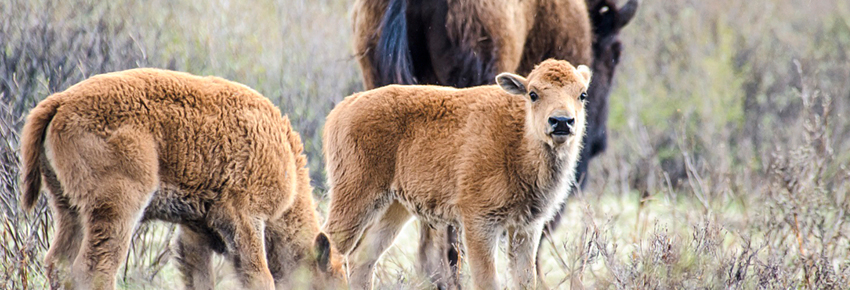
The new calves are healthy and doing well. They are mingling with the herd, napping in the sun and playing. For the next few months, the calves will stay close to their mothers as they explore their new world. Their arrival is key part of the project as it will help the herd anchor to the landscape and adopt it as their new home.
Follow the herd from home! See what life is like for the calves by watching our new webisode on YouTube. Share it with your friends and family on social media.
-
April 21, 2017: Cliques, leaders and rebels: herd dynamics are forming
April 21, 2017: Cliques, leaders and rebels: herd dynamics are forming
The herd arrived in Panther Valley home in early February, and they’re settling into their new home. Part of that process is figuring out who’s who in the herd. We’ve been keeping a close eye on them and starting to notice personalities starting to form.

In the past few weeks, cow #12 has caught our attention. She’s normally the first cow to feed which could be a sign that she’s becoming a leader in the group.
This is pretty exciting because bison tend to organize themselves into matriarchal societies – like herds of elephants. They are normally led by older females who know the way to the best food and watering holes.
It’s too early to tell if she will grow up to be queen of the herd, but we will continue to keep an eye on her and other social dynamics as the animals continue to anchor to their new home.

Photo: Karsten Heuer/Parks Canada

Photo: Dan Rafla/Parks Canada
Context
Over a century ago, Plains Bison were hunted to near extinction throughout the Great Plains and the eastern slopes of the Rocky Mountains, including the area that became Banff National Park. The consequences have been significant, including reduced biodiversity and impacts to natural processes in the ecosystem.
As a keystone species, bison influence many parts of the ecosystem. Their grazing and wallowing create habitat for plants and other animals, especially those found in grassy meadows. The movement of bison herds redistributes nutrients throughout the ecosystem. Their loss has also deeply affected Indigenous Peoples, who have vital cultural connections with bison.

Photo: Dan Rafla/Parks Canada
Bison Reintroduction
In 2017, 16 healthy Plains Bison were translocated from Elk Island National Park to Banff National Park. For decades, Parks Canada has contributed to the reintroduction of bison across Canada, the USA and even Russia, by providing disease-free Plains and Wood Bison from Elk Island National Park. This translocation program has started many new herds and is significant to global bison conservation.

Photo: Karsten Heuer/Parks Canada
Outcomes
As of 2024, with the first seven years of the bison reintroduction project complete, the herd at Banff National Park is healthy and has grown rapidly to over 130 animals. Significantly, this new herd is only the 5th free-roaming population of this imperilled species in the world, within historic Plains Bison range.

Photo: Karsten Heuer/Parks Canada
Working together
Much of the project’s success is due to the weaving of Indigenous ceremonies and cultural knowledge with western science. This has been achieved through important collaboration with many First Nations, including the Stoney Nakoda Nations (Bearspaw, Chiniki and Goodstoney), Siksika Nation, Piikani Nation, Kainai Nation, Tsuut’ina Nation, the Ktunaxa and Shuswap Bands, the Samson Cree Nation, and the Rocky View Métis District of the Otipemisiwak Métis Government. Many partners from academia, surrounding municipalities, the provincial government, and non-governmental organizations have also been pivotal.

Active management
The free-roaming bison population is kept within a 1200 km2 home range within the national park by using short sections of wildlife-friendly fencing, placed where bison might try to leave the park, and by herding them back when they leave park boundaries.
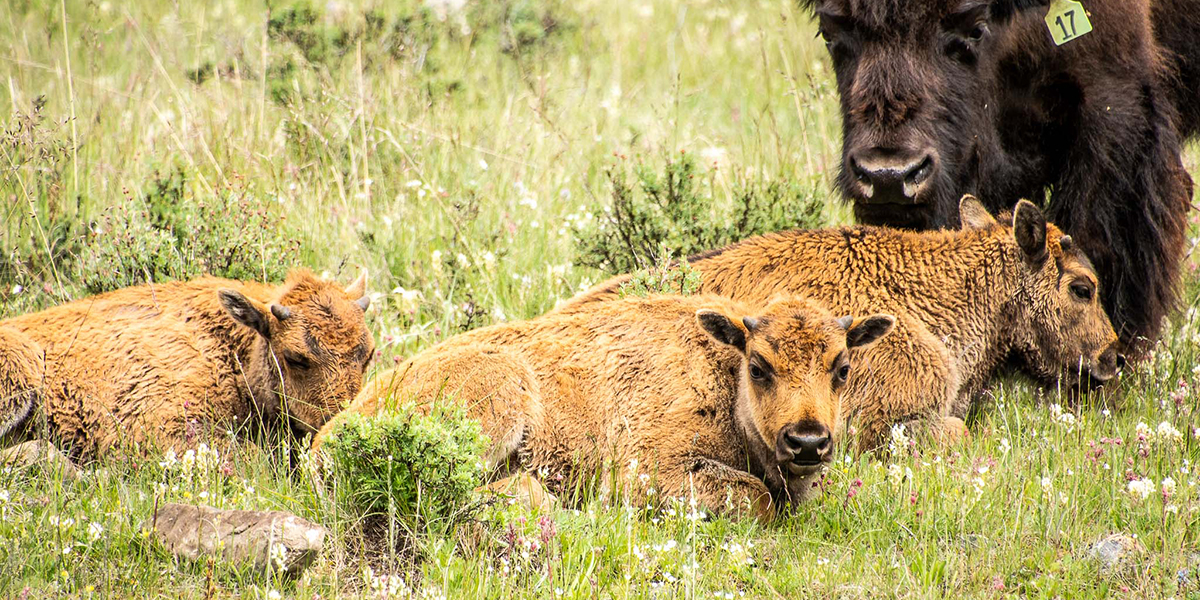
Photo: Karsten Heuer/Parks Canada
Looking ahead
With the completion of the first seven years of the project, Parks Canada, Indigenous groups, and stakeholders are exploring what a broader bison program might look like, including trans-jurisdictional possibilities and regulated Indigenous harvest of bison to manage the growing herd. Collaborating with partners across boundaries will be key in accommodating the growing herd over the long term.

"Bison need to be wildlife, like other species. They want to move across our human-made boundaries. How we meet their request, as a society, will determine the long-term success of this project."
Karsten Heuer, Bison Reintroduction Project Manager, Parks Canada
Banff Bison: Multimedia
Experience life in the field as we bring you video footage of key moments in the reintroduction journey.
Blogs from the early days of reintroduction:
2021
2020
2019
2018
2017
- Date modified :